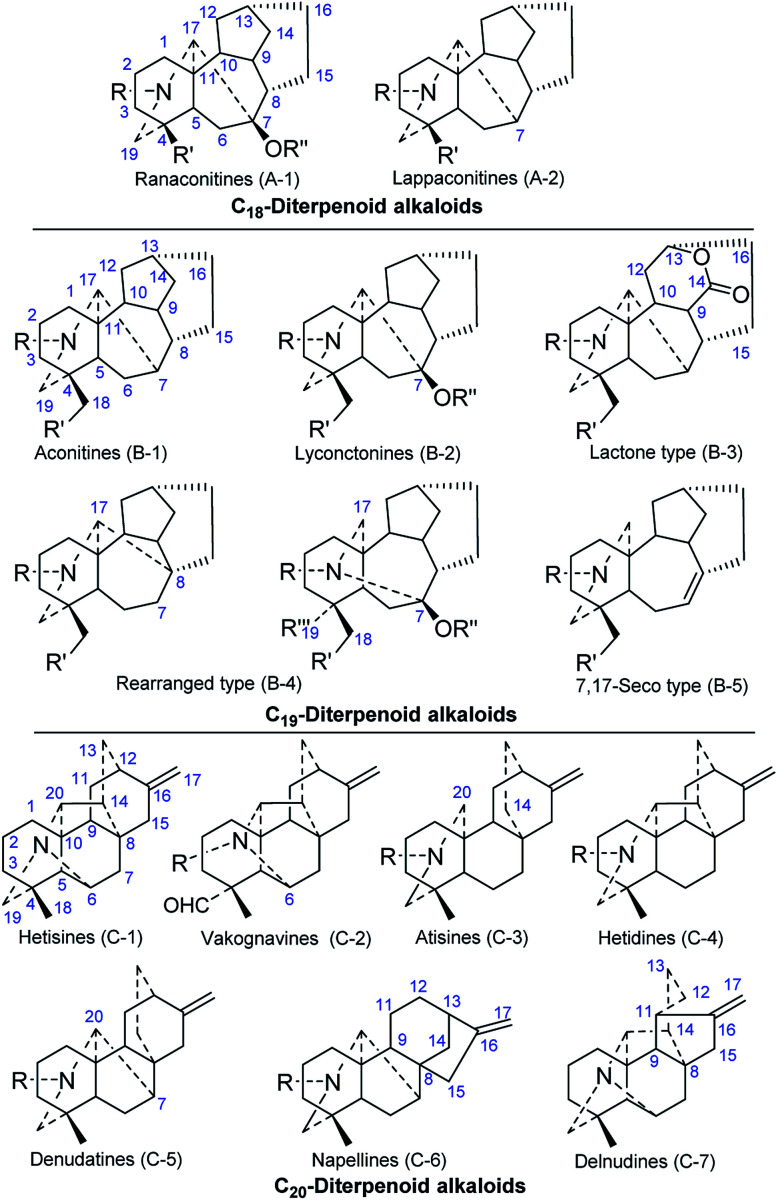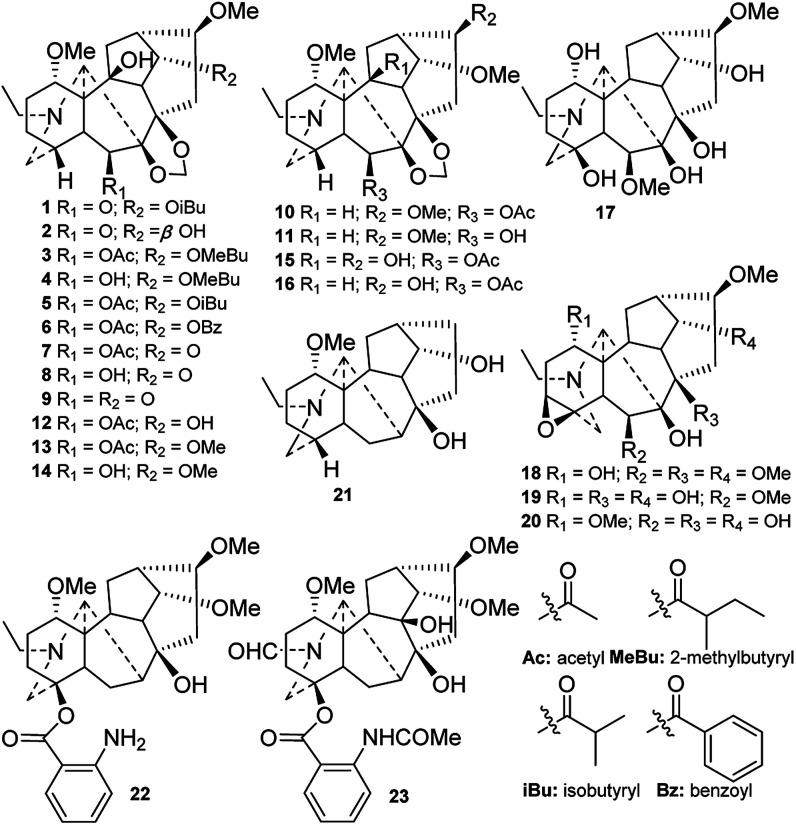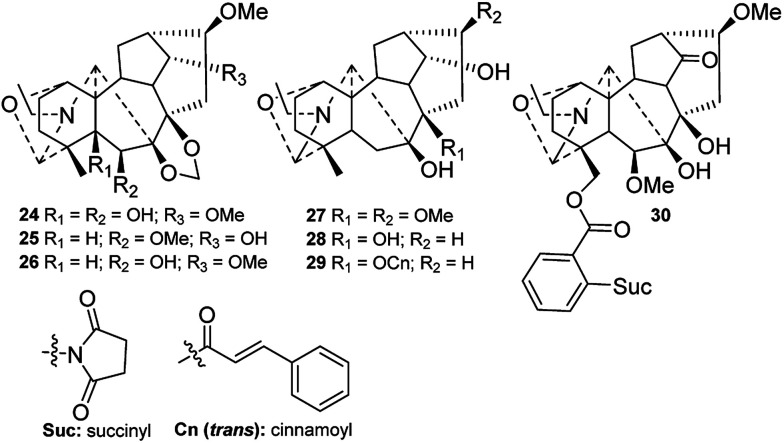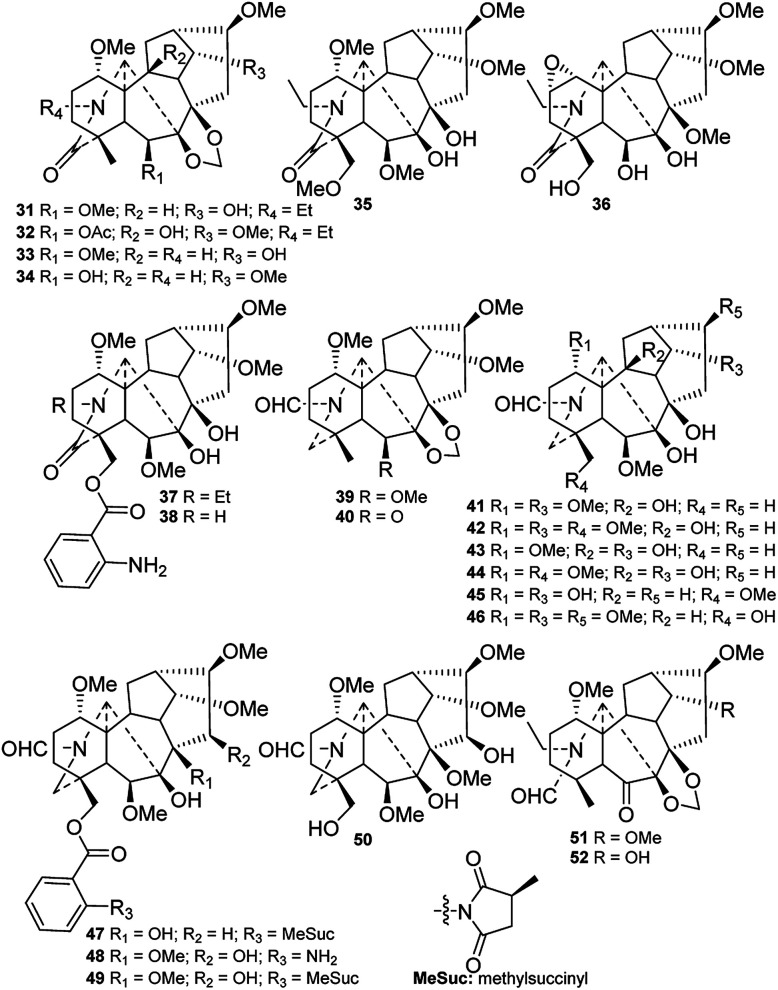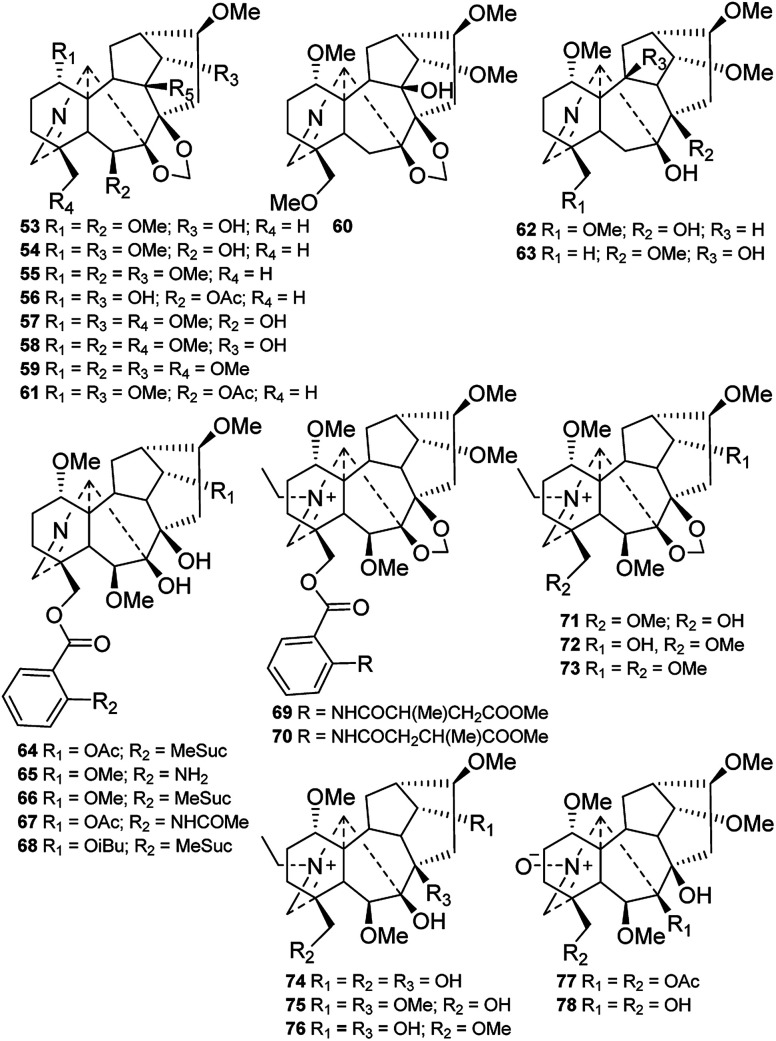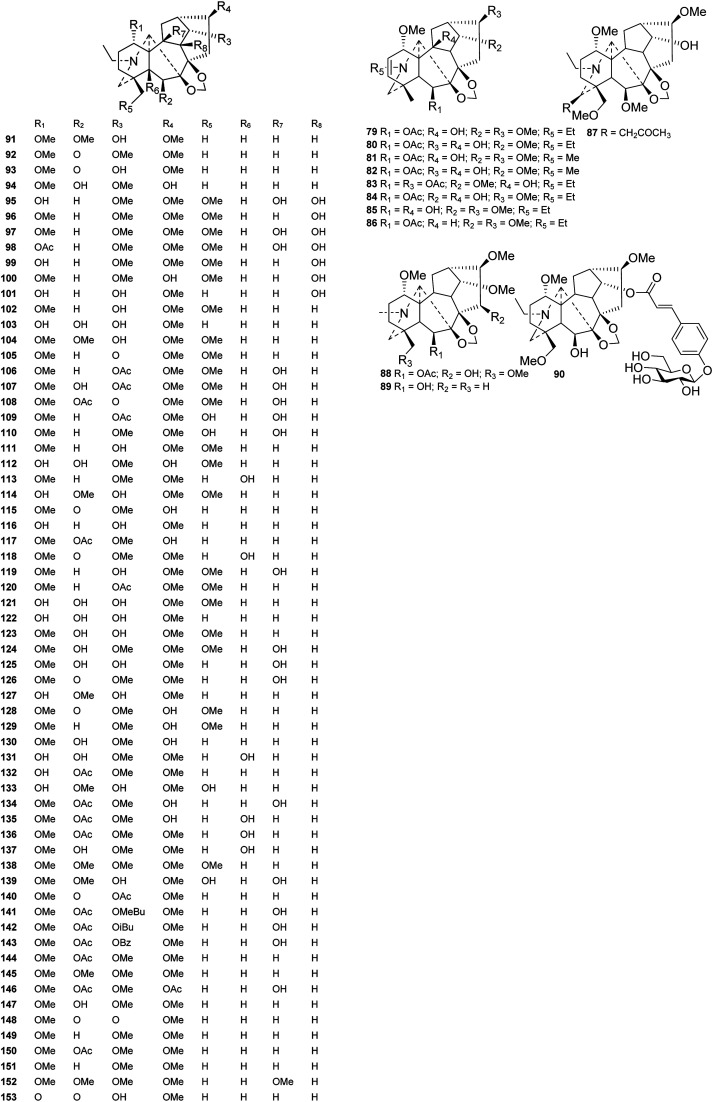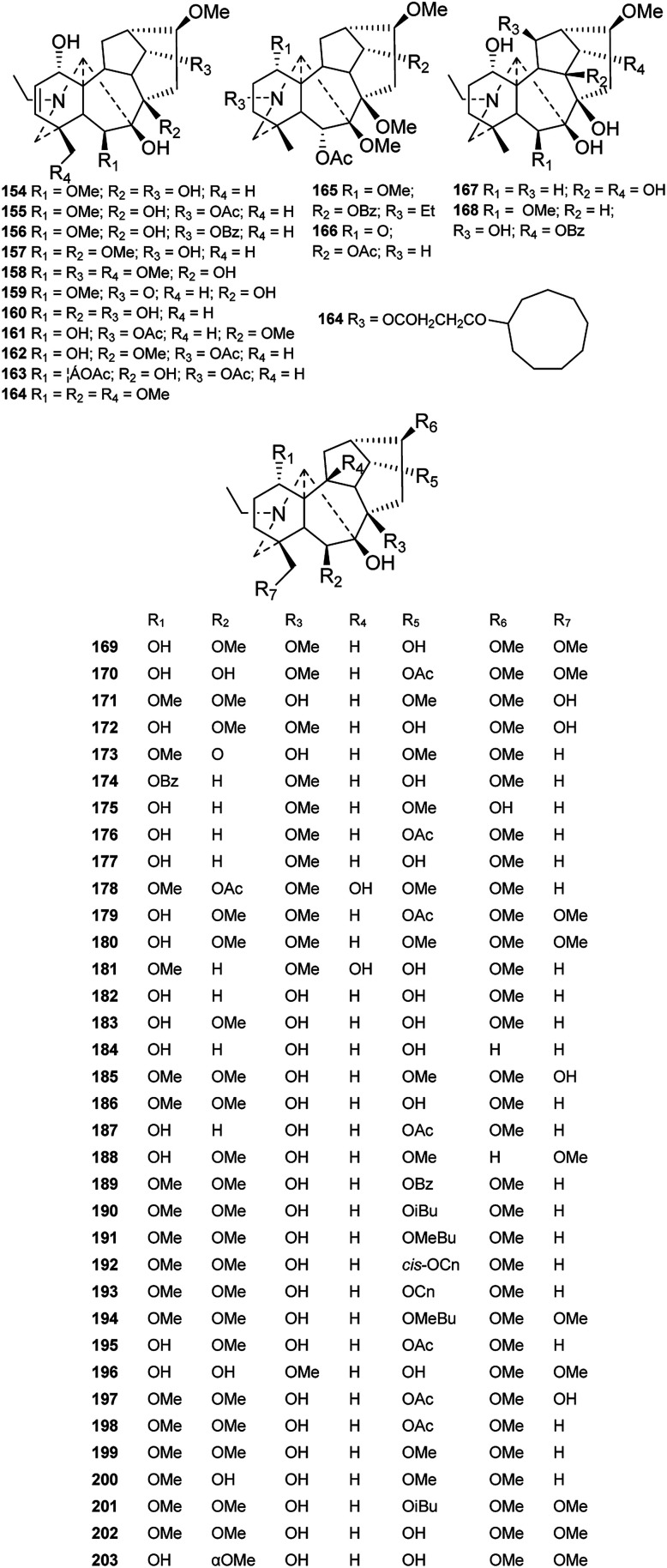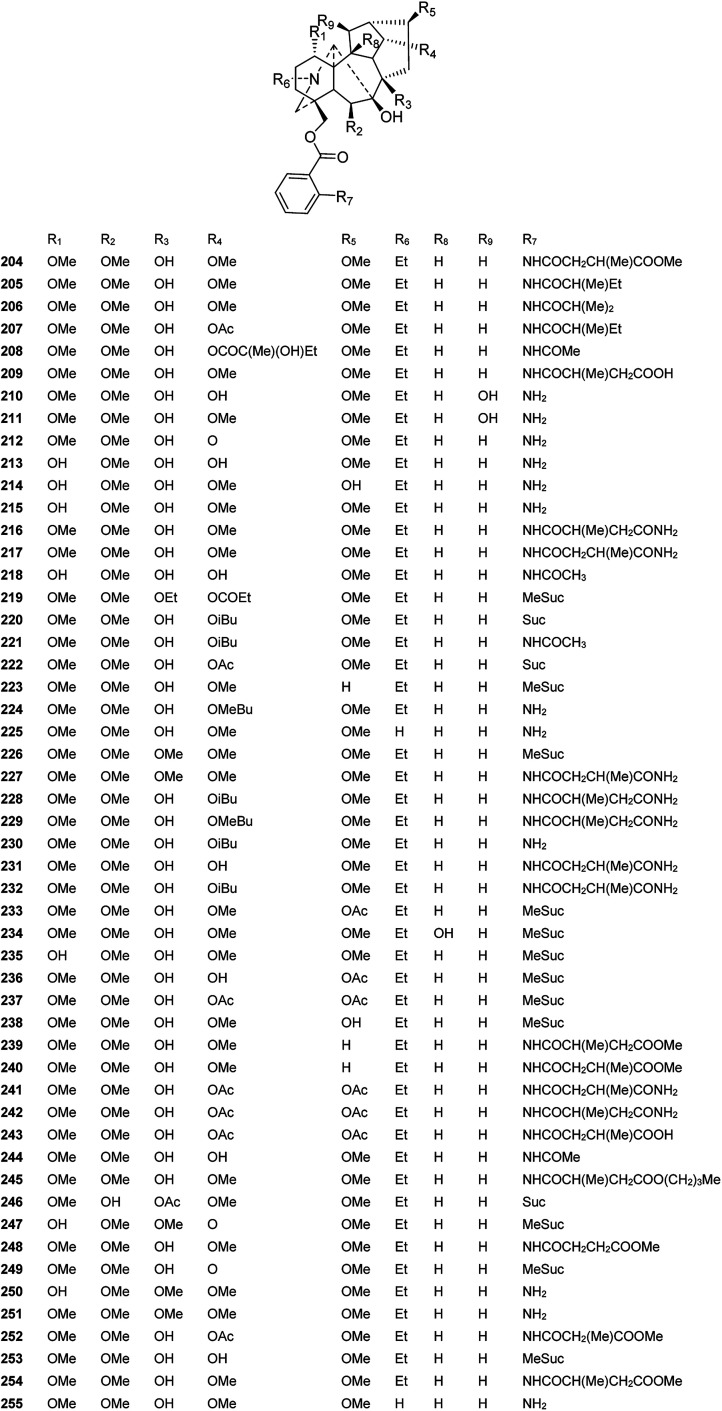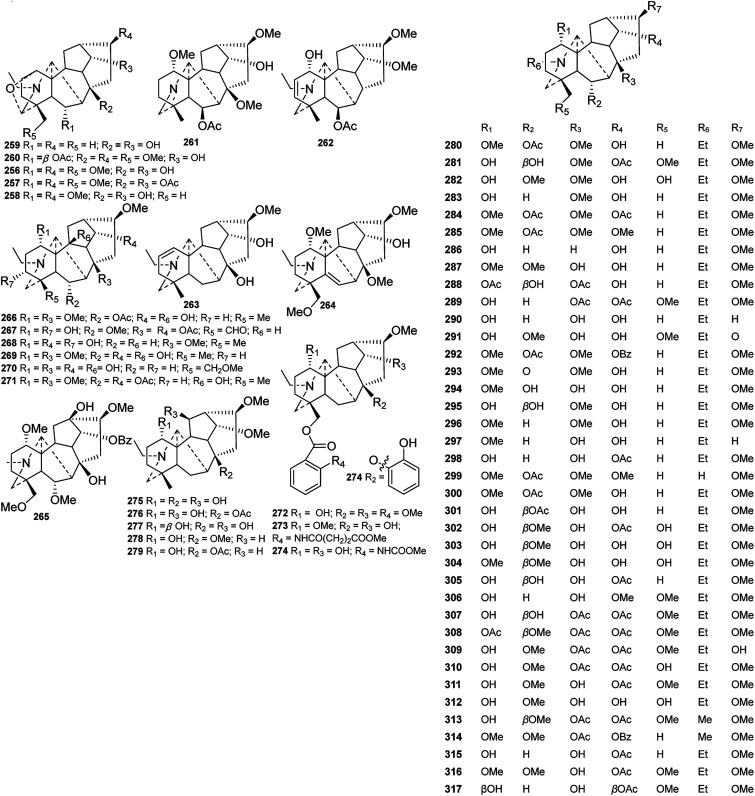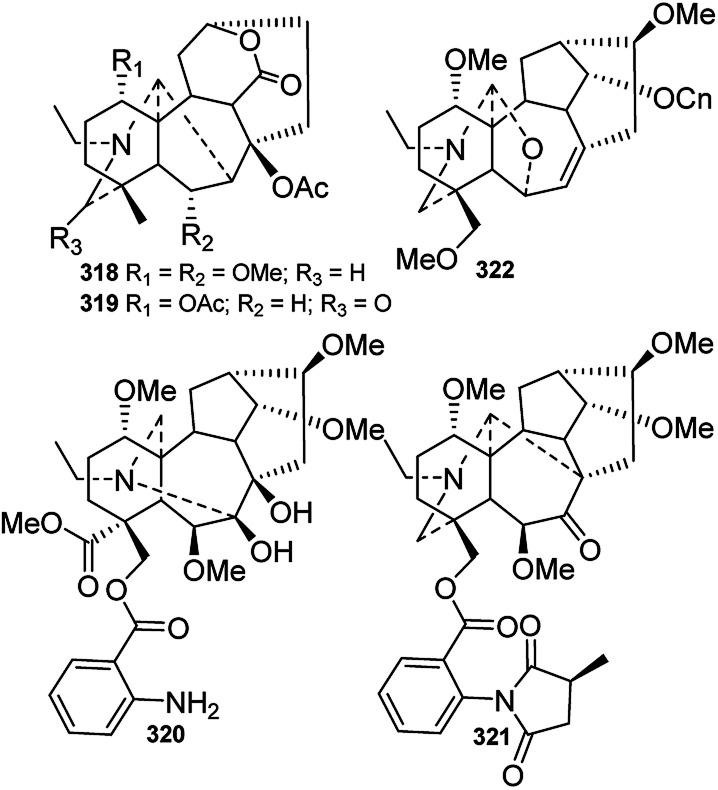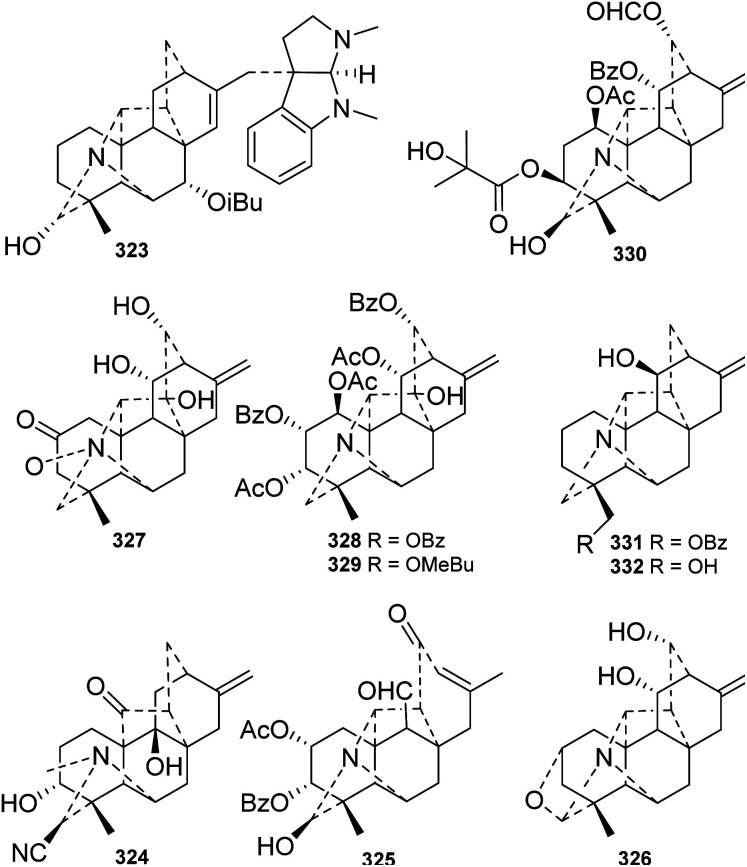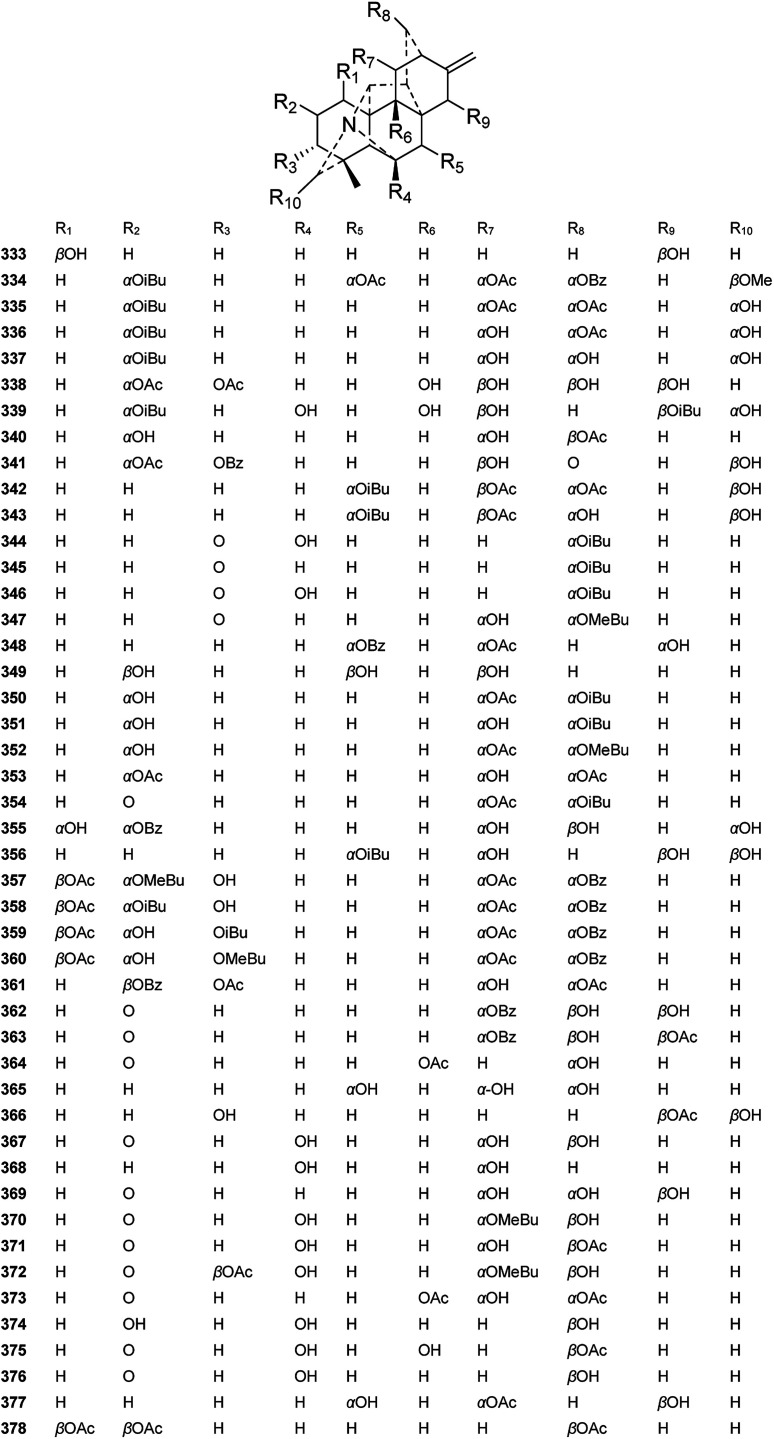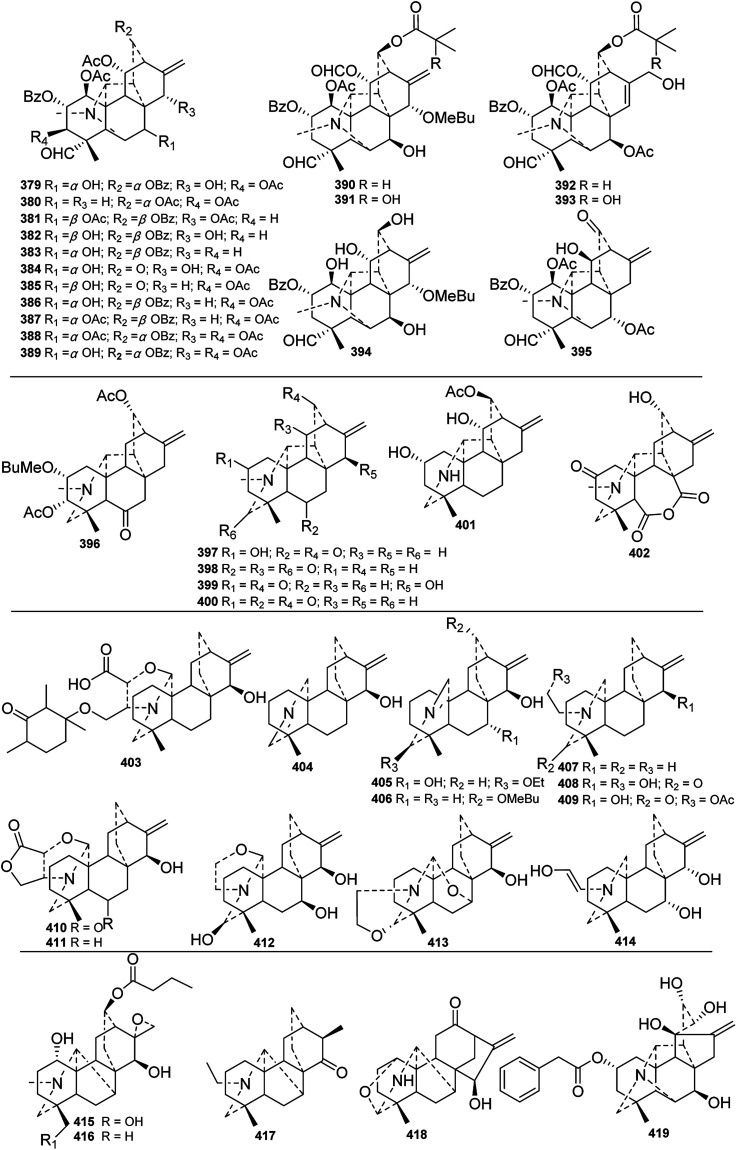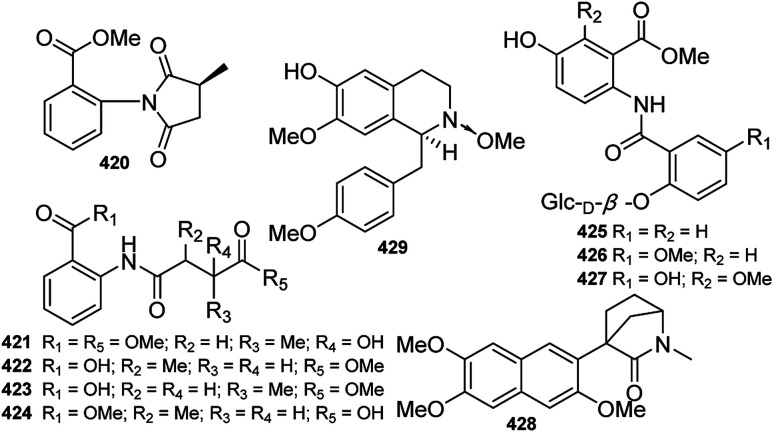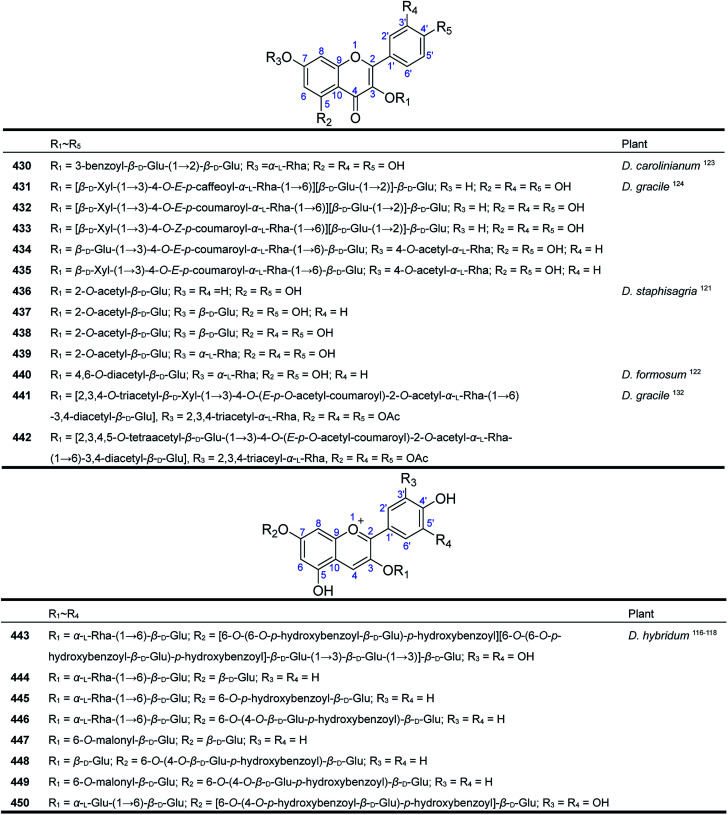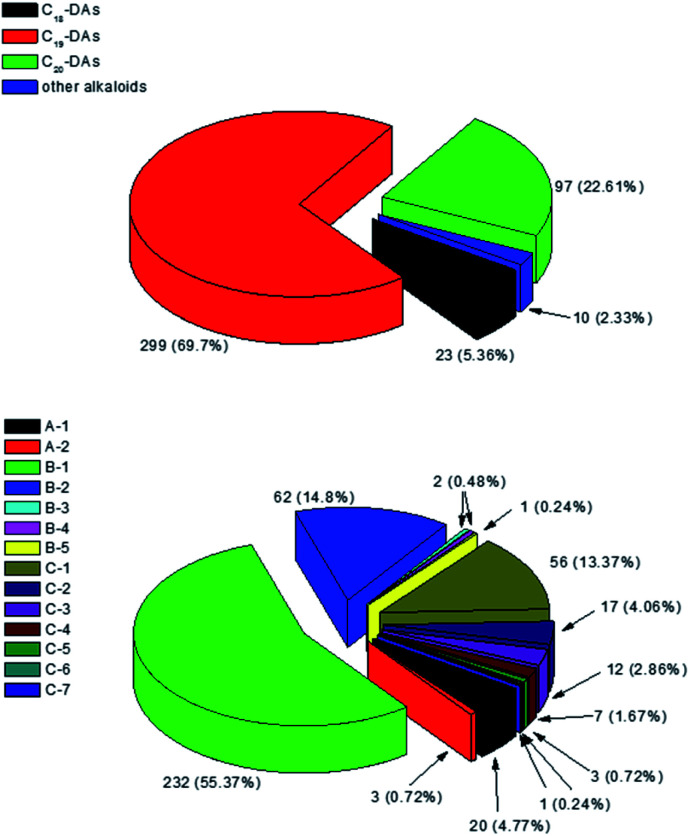Abstract
Species of the genus Delphinium have been extensively used for different purposes by various civilizations worldwide since antiquity. Phytochemical investigations on Delphinium plants in the last four decades (1980–2019) have afforded a total of 453 new compounds, most of which are diterpenoid alkaloids. These constituents are of great research significance due to their novel structures and broad bioactivities. This review addresses, for the first time, the chemical constituents of Delphinium plants and the biological properties of these compounds to facilitate future research.
Multiple chemical constituents, mainly diterpenoid alkaloids, from Delphinium showed great research significance for their novel structures and broad bioactivities.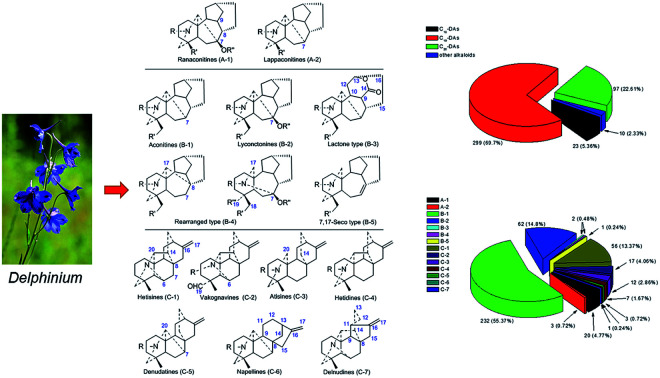
1. Introduction
The genus Delphinium (Larkspur), an important member of the family Ranunculaceae, comprises approximately 365 species, which are distributed mainly in northern temperate regions, including in Asia, Europe, and North America.1 There are also a few species growing in North Africa, such as D. cossonianum and D. staphisagria in Morocco,2,3D. macrocentrum in Kenya,4 and D. leroyi in Ethiopia.5 Notably, among the 365 Delphinium species, 232 (200 endemic) have been found in China.6Delphinium plants prefer cool and moist conditions and mainly grow in alpine-cold regions, such as the Hengduan Mountains region in Southwest China, which is the most important centre of diversity and speciation of this genus, as at least 167 Delphinium species have been found in this region.
Delphinium plants have been extensively used for different purposes by various civilizations worldwide since antiquity. Delphinium plants feature various coloured flowers ranging from white, yellow, and red to blue, and they have been cultivated as horticultural plants in Europe since the 17th century. Currently, Delphinium plants are one of the most famous and popular horticultural plants around the world, and thousands of ornamental varieties of Delphinium have been cultivated and applied widely in bonsai, gardens, and greenbelts. Delphinium flowers are also an important source of natural dyes; for example, yellow dye for silk has been extracted from D. zalil flowers for a long period of time in Iran and India.7 In addition, Delphinium plants are traditionally used as herbal pesticides against lice and scorpions since the time of Dioscorides (in the 1st century A.D.), approximately two thousand years ago.8 During the battle at Waterloo, the British army also used the powders of D. staphisagra and D. peregrinum to prevent and kill lice.9 In China, there are five Delphinium species, namely, D. grandiflorum, D. albocoeruleum var. przewalskii, D. chefoense, D. korshinskyanum, and D. likiangense, that have been used to kill the larvae of mosquito, lice, and flies.6 Most importantly, for centuries, plants of this genus, mainly their tubers and roots, have been extensively used as herbal medicines—in Turkey to treat epilepsy, tetanus, rabies, and emesis; in Iran to treat disorders of the spleen, jaundice, a nd dropsy; and in Nepal to treat fever and wounds.7,8 In China, Delphinium plants have a long history as folk medicines for the treatment of many kinds of diseases, such as traumatic injury, rheumatism, enteritis, influenza, oedema, asthma, ringworm, scabies and other skin diseases, as well as stomach ache, migraine, tooth ache, neuralgia, and other kinds of pain. At least 18 species of Delphinium have been used medically in Chinese traditional medicine (TCM) because of their unique and proven therapeutic effects.6
Since the end of the 18th century, the chemical constituents in Delphinium plants have been investigated. Several earlier studies have attempted to isolate anthocyanin pigments from Delphinium flowers, and the first anthocyanin (delphinin) was identified from D. consolida in 1915 by Willstätter et al.10 At almost the same time, research on Delphinium alkaloids, mainly the diterpenoid alkaloid (DA) components, was also conducted.11 The DAs in Delphinium plants have attracted the attention of scientists for a long time, and most studies on these plants have been devoted to the DA components. In addition, the non-alkaloidal constituents of Delphinium plants have also been studied. To date, thousands of components with diverse chemical structures, including alkaloids, flavonoids and other phenolic compounds, fatty acids, terpenoids and steroids, have been isolated from Delphinium plants. These constituents offer novel structures and broad and impressive biological activities, including antioxidant, antiparasitic, antiphlogistic, antineoplastic, and immunoregulatory effects.
Several review articles and monographs regarding the distribution and physiological and NMR spectroscopic data of naturally occurring DAs, which have mainly been isolated from Delphinium and its sibling genera Aconitum and Consolida, have been published.12–15 However, to date, there has been no individual and comprehensive review of the chemical constituents of the Delphinium genus. Therefore, this review was prepared to summarize the structural features and biological activities of the chemical constituents from Delphinium species for the first time. The aim of this review is to provide a complete overview of the chemical constituents of the Delphinium genus reported in the last four decades (from 1980 to 2019), which will facilitate further research and exploitation of this genus.
2. Alkaloids
In addition to the genera Aconitum and Consolida, Delphinium is a genus in the Ranunculaceae family that is well known for its characteristic DA components.16,17 DAs are clearly the major constituents of Delphinium plants, and most of the published articles are devoted to DA components. In the past forty years, a large number of biologically active and structurally complex DAs have been isolated from various species of Delphinium. Table 1S† lists the names, plant sources, types, and the references of the new DAs isolated from Delphinium plants in the last four decades. Structurally, DAs are usually classified as C18-, C19-, or C20-DAs, which can be further divided into several to dozens of subtypes. Fig. 1 shows the fourteen subtypes of DAs that have been found in Delphinium plants in the last four decades. Herein, the new DAs as well as other alkaloids isolated from Delphinium plants are summarized by category.
Fig. 1. Subtypes of DAs covered in this review.
2.1. C18-Diterpenoid alkaloids
The C18-DAs, also called “bisnorditerpenoid alkaloids”, are a small sub-group of DAs.18 Compared with C19-DAs, C18-DAs are distinguished by the absence of C-18, and their C-4 moiety is a methine or an oxygenated quaternary carbon. C18-DAs can be classified into two subtypes based on whether an oxygen-containing functionality is attached at C-7, namely, lappaconitine-type compounds (A-2), which do not possess an oxygen-containing functionality at C-7, and ranaconitine-type compounds (A-1), which do have an oxygen-containing functionality at this position.
To the best of our knowledge, only 23 new C18-DAs from Delphinium plant have been reported in the last four decades, and they were obtained from 7 different species (Fig. 2). Most of these compounds are ranaconitine-type C18-DAs, with the exception of giraldine I (21) from D. giraldii,19 delphicrispuline (22) from D. crispulum,20 and naviconine (23) from D. naviculare var. lasiocarpum,21 which are lappaconitine-type compounds. Sixteen ranaconitine-type C18-DAs possessing a 7,8-methylenedioxy group were reported, and these compounds are anthriscifolcones A and B (1 and 2) and anthriscifoltines A–G (3–9) from D. anthriscifolium var. majus,22–24 and anthriscifolcines A–G (10–16) from D. anthriscifolium var. savatieri.25,26 Most of them contain a 10-OH substituent, and the exceptions are alkaloids 10–11 and 16. Three of the ranaconitine-type C18-DAs, namely, delboxine (18) from D. bonvalotii,27 14-demethyltuguaconitine (19) from D. stapeliosum,28 and tiantaishansine (20) from D. tiantaishanense,29 contain a 3,4-epoxide unit. Giraldine I (21) was characterized by the lack of an oxygenated substituent at C-16.19 Alkaloids delphicrispuline (22) and naviconine (23) possess an anthranoyl group at C-18,20 and 23 features an N–CHO formamide group instead of an N-ethyl group.21
Fig. 2. C18-DAs from Delphinium plants.
2.2. C19-Diterpenoid alkaloids
The majority of naturally occurring DAs are C19-DAs, and they are usually regarded as the representative type of DAs. In-depth investigations of C19-DAs in chemical and pharmacological fields have been carried, and more information is available on these compounds than on C18- or C20-DAs. According to their molecular skeletons, C19-DAs can be divided into six types, namely, lycaconitines (B-1), aconitines (B-2), lactones (B-3), 7,17-seco derivatives (B-4), rearranged compounds (B-5), and pyro derivatives. In the last four decades, a total of 299 new C19-DAs belonging to these five types have been isolated from Delphinium plants.
2.2.1. Lycaconitines
In Delphinium plants, lycaconitines are the most common type of C19-DAs. A total of 232 new lycaconitine-type C19-DAs were isolated from Delphinium plants in the last four decades. The lycaconitine-type C19-DAs are characterized by the presence of an oxygenated group at C-7, and it is usually a 7-OH or a 7,8-methylenedioxy group. Based on the state of the N-atom, lycaconitine-type C19-DAs can be further divided into four subtypes, namely, the N,O-mixed acetal sub-type, the amide sub-type, the imine and quaternary ammonium sub-type, and the amine sub-type.14
In the last four decades, only seven lycaconitine-type DAs (24–30) with an N–C(19)–O–C(1) mixed acetal unit were found (Fig. 3). Among them, graciline (28) and 8-O-cinnamoylgraciline (29) are characterized by the absence of an oxygenated group at C-16,30 and alkaloid 29 features a cinnamoyl unit at C-8.2 In addition, laxicymine (24) from D. laxicymosum var. pilostachyum has a rare 5-OH group,31 and grandifloricine (30) from D. grandiflorum contains a ketone carbonyl at C-14 along with an N-(succinimido)anthranoyl group at C-18.32
Fig. 3. Lycaconitines with mixed acetal unit from Delphinium plants.
Twenty new amide lycaconitines were reported in the studied period (Fig. 4). Alkaloids 31–38 contain an N–C(19) O lactam group, which might be formed by the carbonylation of 19-OH.33–37 Budelphine (36) from D. buschianum possesses a rare 1,2-epoxy group.36 There are 12 alkaloids (39–50) with an N–CHO formamide group formed from a C-21 aldehyde.4,38–45 Among these compounds, alkaloids 41–45 are DAs that have no oxygen-containing group at C-16.4,39–41N-Formyl-4,19-secopacinine (51)45 and N-formyl-4,19-secoyunnadelphinine (52)38 from D. elatum contain another kind of formamide, which is formed from C-19 aldehydes.
Fig. 4. Amide lycaconitines from Delphinium plants.
Sixteen lycaconitine-type DAs with an imine group at C-19 were isolated from Delphinium plants (Fig. 5). Nine of these DAs (53–61) contain a 7,8-methylenedioxy group,29,45–51 and of these, caerunine (60) from D. caeruleum possesses a 9-OH group.50 Another five imine DAs (64–68) contain a 7,8-diol group along with an anthranoyl group at C-18.7,37,52–54 In addition, orthocentrine (63) from D. orthocentrum possesses an 8-OMe moiety along with a 10-OH group.55 Eight quaternary ammonium bases, including pseudorenines A and B (69 and 70), and pseudophnines A–D (71, 73–74, and 76) from D. pseudoaemulans,48 and sharwuphinine B (72) from D. shawurense,56 naviculine (75) from D. naviculare var. lasiocarpum21 were reported, although these might be artefacts of the extraction and isolation procedure. Sharwuphinine A (76) from D. shawurense57 and chrysotrichumine A (77) from D. chrysotrichum58 are both alkaloids with a nitrone group between C-17 and C-19.
Fig. 5. Imine lycaconitines from Delphinium plants.
A total of 177 new amine lycaconitine-type C19-DAs have been reported, and they can be subdivided into three groups according to their oxygenated substituents at C-7 and C-18, namely, the 7,8-methylenedioxy group, the 7-OH group, and the 7-OH/18-anthranoyl group.
Seventy-six new lycaconitine-type alkaloids with a 7,8-methylenedioxy unit have been reported in the last four decades (Fig. 6). Among these alkaloids, eight (79–86) contain a Δ2,3 group, including siwanines A–D (79–82) from D. siwanense var. leptogen,59 siwanine E and F (82 and 83) from D. siwanense,60 deacetylswinanine A (85) from D. orthocentrum,55 and tatsiensine (86) from D. tatsienense.61 Notably, iliensine A (90) from D. iliense features a 4-O-β-d-glucose-cinnamate ester, making it the first example of a natural DA containing a glucose moiety.62 Pseudouridine B (87) from D. pseudoaemulans possesses a rare acetonyl group at C-19.48 The remaining alkaloids contain only common oxygenated groups, such as OH, O, OMe, and OAc groups, while OMeBu (2-methylbutyryl) and OiBu (isobutyryl) groups are less common. In most cases, these oxygenated groups are located at C-1, C-6, C-14, and C-18. There are also a small number of alkaloids with oxygenated groups at C-5, C-9, and C-10. Most of them possess a 16-OMe group, and some have a 16-OH substituent; delretine (146) from D. retropilosum has a rare 16-OAc.63
Fig. 6. Amine lycaconitines with 7,8-methylenedioxy group from Delphinium plants.
Fifty new amine lycaconitines possessing a 7-OH group were reported in the past forty years (Fig. 7). Eleven alkaloids (154–164) containing a Δ2,3 group were reported,26,64–68 and among these, majusine D (164) from D. majus possesses a novel 3-(cyclononyloxy)propanoate ester group at C-14.69 Alkaloids 192 and 193, a pair of isomers from D. cardiopetalum, possess cis- and trans-cinnamoyl groups at C-14, respectively.70 Gracinine (168) from D. gracile has a hydroxyl group at C-10, which is an infrequently substituted position.71 Pergilone (166) and delphiperegrine (165) from D. peregrinum uniquely feature a methoxy group at C-7.72
Fig. 7. Amine lycaconitines with 7-OH group from Delphinium plants.
Fifty-two new DAs belonging to the 7-OH/18-anthranoyl group were reported (Fig. 8). These alkaloids are substituted with anthranilic acid derivatives at C-18. Amidogens are usually substituted by succinyl or methyl-succinyl groups or other amide side chains, which might be formed by the breakage of succinyl or methyl-succinyl groups. Ajanine (208) from D. ajacis possesses a 2-hydroxyl-2-methylbutyroyle ester chain at C-14,73 and alpinine (219) from D. alpinum possesses a propionyl group at C-14.74
Fig. 8. Lycaconitines with 7-OH/18-anthranoyl group from Delphinium plants.
2.2.2. Aconitines
Although aconitine-type C19-DAs represent the most common naturally occurring DAs, the number of these DAs reported from Delphinium plants is much lower than the number of lycaconitine-type compounds. In the last four decades, only 62 new aconitine-type C19-DAs from Delphinium plants were reported (Fig. 9). Several alkaloids possessed at least one uncommon substituent. For example, alkaloids 262, 263 and 264 possess Δ1,2, Δ2,3 and Δ5,6 groups,75–77 respectively, and alkaloids 256–260 possess an N–C(19)–O–C(1) mixed acetal unit.78–82 Staphisadrine (267) from D. staphisagria features an aldehyde at C-18,83 and peregrinine (261) from D. peregrinum var. elongatum has an N C(19) imine.82 Alkaloids 261 and 262 contain a β-oriented OAc group at C-6.75,82 The other alkaloids mainly vary in the quantity, position and orientation of common oxygenated substituents, including OH, OMe and OAc. Most of the oxygenated substituents are located at C-1, C-6, C-8, C-16, and C-19. Alkaloids 269–270 and 266 have a hydroxyl group at C-10,75,84,85 which is a rare substitution pattern. Generally, aconitine-type DAs have a 16-OMe moiety, but cardiopetaline (290) from D. cardiopetalum and souline (297) from D. souliei are exceptions to this statement, as they lack this group at C-16.81,86 Moreover, delstaphisine (309) from D. staphisagria has a 16-OH group,87 and staphisadrinine (291) from D. staphisagria features a ketone carbonyl at C-16.83
Fig. 9. Aconitines from Delphinium plants.
2.2.3. Lactone-, rearranged- and 7,17-seco-type compounds
The other types of C19-DAs are rare (Fig. 10). Two new lactone-type C19-DAs, namely, 8-acetylheterophyllisine (319) from D. denudatum88 and souline B (318) from D. souliei,89 both featuring a hexanolactone C ring, were reported. In addition, two rearranged C19-DAs, grandiflodine B (320) and yunnanenseine A (321), were isolated from D. grandiflorum and D. yunnanense, respectively.90,91 Yunnanenseine A (321) is a typical acoseptine-type rearranged C19-DA in which its C(7)–C(17) bond was rearranged to a C(8)–C(17) bond, forming an additional ketone at C-7. Grandiflodine B (320) features an unusual lycoctonine-type C19-DA skeleton generated via cleavage of the N–C(19) and C(7)–C(17) bonds and the construction of a N–C(7) bond. Leueandine (322) is the only 7,17-seco-type C19-DA from a Delphinium plant, and it possesses a franchetine-type skeleton with a cinnamoyl group at C-14.92
Fig. 10. Lactone-, 7,17-seco-, and rearranged-type DAs from Delphinium plants.
2.3. C20-Diterpenoid alkaloids
Although C20-type DAs account for a relatively small proportion of DAs in terms of quantity, they are much more structurally diverse than C19-type DAs. The skeletons of C20-DAs are fairly complex, and more than 20 subtypes have been defined.93 As listed in Table 1S,† approximately 89 new alkaloids belonging to seven of the subtypes of C20-DAs were isolated from Delphinium plants in the last four decades.
Hetisine-type C20-DAs (C-1), which are characterized by a heptacyclic system with an N–C(6) bond, constitute the majority of the new C20-DAs from Delphinium plants. A total of 56 new hetisines were obtained from the Delphinium species (Fig. 11 and 12). These alkaloids vary mainly in the variety, quantity, position and orientation of their oxygenated substituents, including hydroxyl, acetyl, benzoyl, isobutyryl, 2-methylbutyryl, ketone and carbonyl groups. Anthriscifolmine J (330) from D. anthriscifolium var. savatieri features a unique 2-hydroxy-2-methylpropanoyloxy group at C-3 along with a formyloxy group at C-13,94 and grandiflodine A (324) from D. grandiflorum has a rare cyano group at C-18.90 14-Hydroxyhetisinone N-oxide (327) from D. gracile is a rare hetisine-type N-oxide,95 and delatisine (326) from D. elatum possesses an N–C(19)–O–C(2) mixed acetal unit.96 In addition, several structurally novel hetisine-type C20-DAs were reported. Anthriscifolsine A (325) from D. anthriscifolium var. majus features a seco C ring generated through unprecedented C(11)–C(12) bond cleavage in the hetisine skeleton.97 The N–C(17) bond in grandiflodine A (324) can be cleaved, forming an additional ketone carbonyl at C-17.90 Leptanine (323), which was isolated from D. leptocarpum, is a dimeric alkaloid consisting of a hetisine-type C20-DA part and an indolinonepyrrole fragment. According to X-ray crystal structure analysis, the indolinonepyrrole fragment was bound to the hetisine-type C20-DA part through an α-directed (relative to the indoline core) C(17)–C(3′) covalent bond.98
Fig. 11. Hetisine type C20-DAs from Delphinium plants.
Fig. 12. The hetisine type C20-DAs from Delphinium plants.
Vakognavine-type C20-DAs (C-2) have an N–C(19) seco hetisine skeleton in addition to a formyl group at C-4. During the past forty years, 17 new vakognavines were isolated from 6 Delphinium species (Fig. 13). Generally, vakognavine-type C20-DAs seldom have a C(15) C(16) bond, but anthriscifolmines G (393) and H (392) from D. anthriscifolium var. savatieri are exceptions to this statement.99 In addition, anthriscifolmines E–H (390–393) feature a rare formyloxy group at C-11 along with a unique 2-hydroxy-2-methylpropanoyloxy group or a 2-methylpropanoyloxy group at C-13.99
Fig. 13. The vakognavine-type, hetidine-type, atisine-type, denudatine-type C20-DAs from Delphinium plants.
Atisine-type C20-DAs (C-4) have always been regarded as the biosynthetic precursors of the other C20-DAs, possess a relatively simple pentacyclic framework. Twelve atisines from seven Delphinium species were reported (Fig. 13). Structurally, isoazitine (404) and 13-(2-methylbutyryl)azitine (406) each possess an azomethine between N and C-19 or C-17.3,100 Uncinatine (414) from D. uncinatum bears an uncommon N–CH CHOH group.101 Delphatisine A (412)102 and delphatisine D (413)58 possess oxazolidine rings formed by a carbinolamine ether linkage between C-20 and C-17 or C-19, respectively. Delphatisines B (411) and C (410) feature a γ-lactone-fused oxazolidine ring.103 The γ-lactone ring in honatisine (403) was open, forming an extra carboxylic acid group at C-22. In addition, a unique 1′,3′,5′-trimethyl-4′-oxocyclohexyloxy unit was substituted at C-24.104
Other subtypes of C20-DAs were also reported. Six new hetidine-type C20-DAs (C-3), including anthriscifolmine I (396) from D. anthriscifolium var. savatieri,94 carduchoron (398) and delcarduchol (399) from D. carduchorum,105 macrocentrine (401) from D. macrocentrum,4 cardionidine (402) from D. cardiopetalum,106 and 2-dehydrodeacetylheterophylloidine (400) from D. pentagynum,52 were acquired. Among these alkaloids, cardionidine (402) features an anhydride function in its B ring.106 Three denudatine-type DAs (C-5), including anthriscifolmines A (416) and B (415) from D. anthriscifolium var. savatieri, which possess a 16,17-epoxy group and a butyryl group at C-13,107 and cordizine (417) from D. corymbosum, which possesses a CH3-17β angular methyl group, were reported.108 Moreover, a napelline-type C20-DA (C-6), norsongoramine (418), with an N–C(19)–O–C(1) mixed acetal unit was obtained from D. tamarae,109 and a delnudine-type C20-DA (C-7), trichodelphinine F (419), possessing a rare phenylacetyl group at C-2, was isolated from D. trichophorum.110
2.4. Other alkaloids
In addition to DAs, other types of alkaloids have also been isolated from Delphinium plants (Fig. 14). Several amide alkaloids from Delphinium plants have been reported. Five new acyl anilines, delamides A–E (420–424), which possessed an O-ester aniline bearing an amide side chain, were isolated from D. brunonianum by Zou et al.111 Diaz et al. reported the isolation of three new anthranilic acid derivatives (425–427), also called dianthramides, from tissue cell cultures of D. staphisagria.112 In addition, a novel lactam (428) possessing a 2-azabicyclo[2.2.1]heptane unit bearing a trimethoxy naphthalene ring, was isolated from D. caeruleum.113
Fig. 14. The other alkaloids from Delphinium plants.
Tetrahydroisoquinoline alkaloids are widely distributed in the Ranunculaceae family. While little attention has been paid to the isoquinoline alkaloids in Delphinium plants, a new benzyltetrahydrobenzylisoquinoline alkaloid, O-methylroefractine N-oxide (429), was found in D. fangshanense.114
3. Flavonoids
Delphinium, the flowers of which have petals of various colours, i.e., white, red, violet and blue, are widely cultivated as one of the most famous horticultural plants in the world. The anthocyanidin pigments in the Delphinium flowers have attracted considerable attention for a long time. As early as 1915, Willstitter isolated the first anthocyanidin pigment, delphinin, from the reddish-purple petals of D. consolida.10,115 During the last four decades, eight new anthocyanidins were reported from different cultivated varieties of D. hybridum (Fig. 14). Two new delphinin glycosides, violdelphin (450)116 and cyanodelphin (443),117 were isolated from the violet petals of D. hybridum cv “Blue Night” and the blue petals of D. hybridum cv “Blue Springs”, respectively. Structurally, violdelphin (450) contains two p-hydroxybenzoic acid units and four hexose substituents in addition to the delphinin core, and cyanodelphin (443) contains four p-hydroxybenzoic acid units and seven glucose units in its structure. In addition, six new acylated pelargonidin 3,7-glycosides (444–449) were isolated from the red petals of D. hybridum cv “Princess Caroline”.118 These pelargonidin glycosides possess various acylated glucoses and rhamnoses at C-3 and C-7. Characteristically, glycosides 447 and 449 are acylated at the 3-glucose residue with malonic acid.
In addition to anthocyanidins, Delphinium plants are also rich in flavonol glycosides. In 1973, Arazashvili et al. first reported the identification of two known flavonol glycosides from the leaves of D. flexiosum and D. elisabethae.119 Dozens of flavonols and their glycosides were isolated from Delphinium plants during the next forty years, including some common and widespread constituents, such as rutin, quercetin, kaempferol, and luteolin as well as their glycosides.120 Eleven new compounds have been reported from four Delphinium species, with the aglycones being kaempferol (434–437 and 440) and quercetin derivatives (430–433 and 438–439) (Fig. 15). The novelty of these flavonol glycosides is mainly determined by the type and position of the acyl groups on the carbohydrate chains. Structurally, flavonol glycosides 436–439 from D. staphisagria possess a 2-O-acetyl glucosyl group at C-7,121 while flavonol glycoside 440 from D. formosum has a 4,6-O-diacetyl glucosyl group.122 Compound 430, a benzoylated quercetin glycoside, was isolated from D. carolinianum,123 and compounds 431–435 are a series of tetraglycosides acylated by caffeic acid and cumaric acid.124
Fig. 15. Flavonoid glycosides from Delphinium plants.
4. Phenolics
A certain number of phenolic compounds, such as benzoic and phenylacetic acid derivatives, have been identified from Delphinium plants.125–127 However, most of these phenolic compounds are common, structurally simple and widely distributed in the plant kingdom; new structures are rarely discovered. Only two new phenolic compounds, namely, 2,5,6-trihydroxypiperonylic acid methyl ester (451) from D. venulosum128 and oxformasine (452) from D. formosum,129 were reported during the studied period (Fig. 16). Oxformasine (452) represents the first benzoxepine derivative from Delphinium species.
Fig. 16. Phenolics and diterpenoid from Delphinium plants.
5. Terpenoids
In contrast to the wide variety of DAs present in Delphinium plants, terpenoids are rare. To date, only one new non-alkaloidal diterpenoid, campylopin (453) from D. campylocentrum, has been reported130 (Fig. 15). Campylopin (453) is the first naturally occurring hetidane-type diterpenoid, and it has great significance for the biosynthesis of diterpenoid alkaloids, as it implies a new biosynthetic pathway from atisane or hetidane-type C20-diterpenes to hetidine-type C20-diterpenoid alkaloids.131
6. Bioactivities
In the past forty years, compounds isolated from Delphinium plants, mainly DAs and flavonols, have been screened for their multiple biological activities, including antineoplastic, antimicrobial, anti-inflammatory, and insecticidal and antifeedant activities, as well as cholinesterase inhibition effects. Some of the tested compounds showed considerable activities. Herein, the bioactivities of the compounds from the Delphinium plants are summarized.
6.1. Anticancer activity
A certain number of natural DAs have been reported to possess antiproliferative activities against various human cancer cell lines, indicating their great potential as new drugs for treating the corresponding cancers.133 New DAs along with known DAs from Delphinium plants have also been reported to have in vitro anticancer activities (Table 1). The atisine-type DA delphatisine C (410) from D. chrysotrichum showed significant cytotoxic activity against A549 cells (IC50, 2.36 μM),103 and its analogue honatisine (403) from D. honanense also displayed impressive cytotoxic activity against MCF-7 cells with an IC50 value of 3.16 μM, making it more effective than the positive control etoposide (IC50, 7.53 μM).104 The cytotoxic activities of five hetisine-type C20-DAs, trichodelphinines A–E (350–354), and one delnudine-type C20-DA, trichodelphinine F (419), against A549 cells were tested.110 The most active compounds (351, 354 and 419) had low IC50 values (18.64, 12.03 and 16.55 μM, respectively), and the other compounds showed moderate cytotoxicities against A549 cells. In addition, known lycaconitine-type C19-DAs, including delpheline, delbrunine, siwanine E, delcorinine, uraphine, nordhagenine A, and delbrunine from D. chrysotrichum and D. honanense, also showed certain anticancer activities against A549 and MCF-7 cells with IC50 values ranging from 9.62 to 35.32 μM.104
Cytotoxic activity of Delphinium alkaloids.
| Plants | Alkaloids | Type | IC50 (μM) | |
|---|---|---|---|---|
| MCF-7 | A549 | |||
| D. chrysotrichum | Delphatisine C (410) | C-4 | >50 | 2.36 |
| Delpheline | B-1 | 17.32 | >50 | |
| Delbrunine | B-1 | 16.50 | 10.63 | |
| Etoposide | — | 7.56 | 1.8 | |
| D. honanense | Honatisine (403) | C-4 | 3.16 | >50 |
| Siwanine E | B-1 | 35.32 | >50 | |
| Delcorinine | B-1 | 18.60 | 31.63 | |
| Uraphine | B-1 | 33.21 | 9.86 | |
| Nordhagenine A | B-1 | 17.38 | 9.62 | |
| Etoposide | — | 7.53 | 1.82 | |
| D. trichophorum | Trichodelphinine A (350) | C-1 | — | 27.62 |
| Trichodelphinine B (351) | C-1 | — | 18.64 | |
| Trichodelphinine C (352) | C-1 | — | 48.08 | |
| Trichodelphinine D (353) | C-1 | — | 52.79 | |
| Trichodelphinine E (354) | C-1 | — | 12.03 | |
| Trichodelphinine F (419) | C-1 | — | 16.55 | |
| Doxorubicin | — | — | 0.60 | |
Although no detailed structure–activity relationship (SAR) study has yet been reported, it seems that C20-DAs have shown more potential to be developed as antitumor drugs on account of their higher efficiency and lower toxicity.13 Especially, the hetisine-type C20-DAs, which have exhibited selective antiproliferative activity on human lung cancer cell A549, deserve further studies to identify more potent antitumor DAs. On the other hand, Delphinium plants have rarely been utilized for the treatment of cancer in TCM. The research presented above suggests that Delphinium plants with abundant DAs have great potential as herbal drugs for treating cancer, but more research is required to confirm this.
6.2. ChE inhibition effects
The discovery of natural ChE inhibitors is an active research area in natural medicinal chemistry due to the involvement of cholinesterases in Alzheimer's disease and related dementias.134 In the early 1990s, methyllycaconitine, one of the principal active constituents of Delphinium species, was found to be an effective ligand for neuronal nicotinic acetylcholine receptor (nAChR) subtypes, which attracted the attention of scientists to the screening of natural cholinesterase inhibitors from Delphinium species. Several Delphinium alkaloids have been reported to exhibit considerable ChE inhibitory effects (Table 2). The aconitine-type C19-DAs 1β-hydroxy, 14β-acetylcondelphine (317), jadwarine-A (270), jadwarine-B (262), and dihydropentagynine (203) from D. denudatum have been found to possess inhibitory effects of AChE and BChE with EC50 values ranging from 9.2 to 34.7 μM.75 Ahmad et al. reported that an isotalatazidine hydrate crystal isolated from D. denudatum showed competitive inhibition of both AChE and BChE with IC50 values of 12.13 μM and 21.41 μM, respectively.135 In addition, the amide alkaloid delamide A (420) from D. brunonianum also showed highly selective AChE inhibitory activity (EC50, 9.7 μM) and was shown to be a mixed-type reversible inhibitor of AChE by kinetic analysis.111
ChE inhibition effects of Delphinium alkaloids.
| Plants | Compounds | Type | EC50 (μM) | |
|---|---|---|---|---|
| AChE | BChE | |||
| D. denudatum | 1β-hydroxy, 14β-acetyl condelphine (317) | B-2 | 19.8 | 31.5 |
| Jadwarine-A (270) | B-2 | 9.2 | 19.6 | |
| Jadwarine-B (262) | B-2 | 16.8 | 34.7 | |
| Isotalatizidine hydrate | B-2 | 12.1 | 21.4 | |
| Dihydropentagynine (203) | B-1 | 11.2 | 22.2 | |
| Allanzanthane A | — | 8.2 | 18 | |
| Galanthamine | — | 10.1 | 20.6 | |
| D. brunonianum | Delamide A (420) | Amide | 9.7 | >50 |
| Rivastigmine | — | 4.7 | >10 | |
6.3. Insecticidal and antiparasitic activities
Delphinium plants have been used as natural insecticides since the time of Dioscorides. Previous studies have indicated that DAs might have evolved in nature to protect Delphinium and Aconitum plants against pests. Hence, searching for valuable natural insecticides from plants that are rich in DAs, which have been shown to be potent and selective ligands of the insect nicotinic receptor, is quite effective.136,137 A series of DAs from Delphinium plants have been shown to possess insecticidal and antifeedant activities. Ulubelen et al. tested the repellency of 8 new alkaloids along with 12 known alkaloids belonging to three subtypes of DAs from Turkish Delphinium species against Tribolium casteneum (Table 3).138 Most of the tested new alkaloids (280, 285, 299, 331, 368–369, and 378) had repellency class III values (40.1–60%) for a short period, and venuluson (369) gave the highest level of repellency (59.37%), suggesting it is a promising candidate for insecticide development.
Repellency of Delphinium alkaloids to T. casteneum.
| Plants | Alkaloids | Type | Repellency (%) | Class |
|---|---|---|---|---|
| D. venulosum | Venulol (368) | C-1 | 31.25 | II |
| Venuluson (369) | C-1 | 56.25 | III | |
| Venudelphine (378) | C-1 | 40.62 | III | |
| Hetisine | C-1 | 59.12 | III | |
| Hetisinone | C-1 | 37.50 | II | |
| D. gueneri | 14-Methyl peregrine (285) | B-2 | 46.87 | III |
| N-Deethyl-14-O-methylperegrine (299) | B-2 | 40.62 | III | |
| Peregrine (280) | B-2 | 53.12 | III | |
| Peregrine alcohol | B-2 | 37.50 | II | |
| Talatisamine | B-2 | 34.37 | II | |
| 14-Acetyneoline | B-2 | 53.12 | III | |
| D. albiflorum | Lycoctonine | B-1 | 46.87 | III |
| D. davisii | 18-Benzoyldavisinol (331) | C-1 | 46.87 | III |
| Karakoline | B-2 | 37.50 | II | |
| D. uncinatum | 14-Acetylvirescenine | B-1 | 43.75 | III |
| Condelphine | B-2 | 40.62 | III | |
| D. formosum | 14-Demethylajacine (244) | B-1 | 40.62 | III |
| Delsemine B | B-1 | 37.50 | II | |
| Delsoline | B-1 | 37.50 | II | |
| D. crispulum | Browniine | B-1 | 46.87 | III |
| D. montanum | Gigactonine | B-1 | 43.75 | III |
Several investigations on the antifeedant activities of Delphinium alkaloids have been performed. The crude alkaloids of D. cyphoplectrum have slight antifeedant and insect repellent activities against the larvae of Spodoptera littoralis.139 González-Coloma et al. tested the insect antifeedant activities of 21 DAs isolated from Delphinium species on Spodoptera littoralis and Leptinotarsa decemlineata. The antifeedant effects of the test compounds were structure- and species-dependent (EC50 values ranging between 0.42–22.5 and 0.1–17.77 μg cm−2 for L. decemlineata and S. littoralis, respectively). The most active antifeedants to L. decemlineata and S. littoralis were found be to the cardiopetaline (259, EC50, 0.42 μg cm−2) and 19-oxodihydroatisine (408, EC50, 0.1 μg cm−2), respectively.140,141 Shawurensine (209) from D. naviculare var. lasiocarpum also showed considerably potent antifeedant activity with EC50 values of 0.42 and 0.81 mg cm−2 against the larvae of Spodoptera exigua in a choice test and no choice test, respectively.142 Generally, the antifeedant activities of C20-DAs are lower than those of C19-DAs, which might be attributed to the species- and structure-related differences in the taste receptor binding to these two classes of DAs,143 and this result suggest that further investigations on the antifeedant effects of these compounds should be concentrated on C19-DAs.
Among the new flavonol glycosides that have been isolated from Delphinium plants, a series of compounds (431–437, 439 and 441–442) have demonstrated high antiparasitic activities.132,144,145 In some cases, the antitrypanosomatid activities of these flavonol glycosides against Trypanosoma cruzi were more potent than that of the reference drug benznidazole. For example, compound 436 showed higher trypanocidal activity (IC50 = 6.5 μM) than benznidazole (IC50 = 15.8 μM) against the epimastigote form of T. cruzi, and compound 432 exhibited higher trypanocidal activity (IC50, 21.2 μM) than benznidazole (IC50, 23.3 μM) against the amastigote form of T. cruzi. These compounds also showed impressive leishmanicidal activities against both the extra- and intracellular forms of three Leishmania species (Leishmania infantum, L. braziliensis and L. donovani), and among these compounds, 439 presented the highest antileishmanial activity. Notably, all of these tested flavonol glycosides showed low toxicity to the corresponding host cells, resulting in higher selectivity indices than the reference drugs, which highlights their potential in the treatment of leishmaniasis and Chagas disease (Table 4).
Antifeedant effects of Delphinium alkaloids to L. decemlineata and S. littoralis.
| Plants | Alkaloids | Type | EC50 (μg cm−2) | |
|---|---|---|---|---|
| L. decemlineata | S. littoralis | |||
| D. cardiopetalum | Hetisinone | C-1 | 13.1 | >50 |
| Cardiopetamine (362) | C-1 | 22.5 | 5.5 | |
| 15-Acetyl-cardiopetamine (363) | C-1 | 12.9 | >100 | |
| Cardiodine (329) | C-1 | 2.2 | 4.4 | |
| D. gracile | Atisinium chloride | C-3 | 3.4 | 2.4 |
| D. stenocarpa | Ajaconine | C-3 | 5.1 | 8.2 |
| D. staphisagria | 19-Oxodihydroatisine (408) | C-3 | >50 | 0.1 |
| Azitine | C-3 | >50 | 1.1 | |
| Isoazitine (404) | C-3 | 6.9 | 4.1 | |
| D. cardiopetalum | Karakoline | B-2 | 0.44 | >50 |
| Cardiopetaline (259) | B-2 | 0.42 | ≈50 | |
| Cardiopetalidine (184) | B-1 | >50 | >50 | |
| 14-Benzoylgadesine | B-1 | >50 | 13.61 | |
| D. montanum | 8-O-Ethylaconine | B-2 | >50 | 8.29 |
| Neoline | B-2 | ≈50 | ≈50 | |
| Gigactonine | B-1 | 13.02 | 9.31 | |
| Delcosine | B-1 | 1.11 | 3.53 | |
| Methylicaconitine | B-1 | 2.78 | 17.77 | |
| D. pentagynum | Gadenine | B-1 | 11.93 | >50 |
6.4. Antifungal and antiviral activity
Delphinium species have been used for the treatment of itches and other skin eruptions in folk medicine, which indicates that the plants may possess constituents with antifungal activities. The new lactone-type C19-DA 8-acetylheterophyllisine (319) from D. denudatum showed antifungal activity against a number of human pathogenic fungi, including Allescheria boydii, Aspergillus niger, Epidermophyton floccosum, and Pleurotus ostreatus, with MIC values of 100, 200, 250, and 150 μg mL−1, respectively.88
Delphinium-derived DAs also showed antiviral activity. The new lycaconitine-type C19-DAs ajacisines C–E (212–214), along with the known alkaloid isodelectine, which were isolated from D. ajacis, exhibited moderate to weak in vitro antiviral effects against respiratory syncytial virus (RSV) with IC50 values of 75.2, 35.1, 10.1, and 50.2 μM, respectively,146 while the positive control (ribavirin) showed an IC50 value of 3.1 μM. The rearranged-type C19-DA grandiflodine B (21), isolated from D. grandiflorum, also displayed a weak inhibitory effect on the growth of RSV with an IC50 value of 75.3 μM.90
7. Conclusions
To the best of our knowledge, investigations on the chemical constituents of Delphinium in the last four decades have reported a total of 453 new compounds, including 429 alkaloids, 21 flavonoids, two phenolic compounds, and one diterpenoid. Among the 429 new alkaloids, 419 are DAs, including 23 C18-DAs, 299 C19-DAs, and 97 C20-DAs, which cover fourteen subtypes of DAs (Fig. 17). In view of the chemical diversity described, the lycaconitine sub-type of C19-DAs (B-1), with 230 new members, are the most abundant DAs in the Delphinium plants, as they accounted for the largest proportion of new compounds (55.37%), followed by aconitine-type C19-DAs (B-2) with 64 new members (14.8%) and hetisine-type C20-DAs (C-1) with 56 new members (13.37%). The other subtypes only account for only a small portion of compounds (less than 20%). Obviously, DAs, especially lycaconitine-type C19-DAs, are characteristic components of the genus Delphinium, which is distinguished from the genus Aconitum by the large number of aonitine-type C19-DAs. Among these new compounds, several possess unprecedented structures, and their various biological activities, including anticancer activity, cholinesterase inhibition effects, insecticidal and antiparasitic activities, and antifungal and antiviral activities, have been reported. These findings underscore the large chemical and biological diversity among the chemical constituents of Delphinium plants, which could not only serve as a vast resource for drug discovery but also help elucidate the therapeutic effects of Delphinium-derived herbal drugs.
Fig. 17. The percentage of each type and sub-type of alkaloids from Delphinium species.
Although phytochemical and biological studies on the chemical constituents of Delphinium species have attracted considerable interest, some deficiencies remain. First, there are approximately 365 Delphinium species around the world, but the chemical constituents of only 87 species and 10 varietal have been studied in the last four decades. Among these species, D. elatum, D. staphisagria, D. anthriscifolium var. savatieri, D. nuttallianum, D. anthriscifolium var. majus, and D. cardiopetalum contributed relatively more new compounds than the other species. The biological constituents of other Delphinium species remain untapped. Hence, an extensive investigation of other species, especially species that are used medicinally, remains necessary. Second, all of the biological activities of the isolated compounds were investigated by using in vitro tests, namely, chemical and cellular models, and there is little research confirming the biological activities of Delphinium compounds using in vivo animal models or on their pharmacological mechanisms. It is necessary to evaluate the biological activities of Delphinium-derived constituents using both in vitro and in vivo models, which will facilitate further research and exploitation of this genus.
Conflicts of interest
There are no conflicts to declare.
Supplementary Material
Acknowledgments
This work was financially supported by a grant from the National Natural Science Foundation of China (No. 31860095), a grant from Guizhou Science and Technology Foundation of China (No. QKHJC[2018]1193), a program for Changjiang Scholars and Innovative Research Team in University (IRT_17R94), and a project of Yunling Scholars.
Electronic supplementary information (ESI) available. See DOI: 10.1039/d0ra00813c
References
- Wang W. C. Guihaia. 2019;39:1425–1469. [Google Scholar]
- de la Fuente G. Gavin J. A. Acosta R. D. Sanchez-Ferrando F. Phytochemistry. 1993;34:553–558. doi: 10.1016/0031-9422(93)80044-S. [DOI] [Google Scholar]
- Díaz J. G. Ruiz J. G. de la Fuente G. J. Nat. Prod. 2000;63:1136–1139. doi: 10.1021/np990453l. [DOI] [PubMed] [Google Scholar]
- Benn M. H. Francis I. Manavu R. M. Phytochemistry. 1989;28:919–922. doi: 10.1016/0031-9422(89)80143-8. [DOI] [Google Scholar]
- Bai Y. Benn M. Phytochemistry. 1992;31:3243–3245. doi: 10.1016/0031-9422(92)83484-G. [DOI] [Google Scholar]
- Li L. Q. and Yuichi K., Flora of China, 2001, vol. 6, pp. 149–222 [Google Scholar]
- Fang S. Benn M. Phytochemistry. 1992;31:3247–3250. doi: 10.1016/0031-9422(92)83485-H. [DOI] [Google Scholar]
- Kolak U. Ozturk M. Ozgokce F. Ulubelen A. Phytochemistry. 2006;67:2170–2175. doi: 10.1016/j.phytochem.2006.06.006. [DOI] [PubMed] [Google Scholar]
- Yan L. P. Chen D. L. Wang F. P. Chin. J. Org. Chem. 2007;27:976–980. [Google Scholar]
- Willstätter R. Mieg W. Ann. Chem. 1915;408:61. doi: 10.1002/jlac.19154080105. [DOI] [Google Scholar]
- Ahrens F. B. Ber. Dtsch. Chem. Ges. 1899;32:1581–1584. doi: 10.1002/cber.18990320238. [DOI] [Google Scholar]
- Yin T. P. Luo Z. H. Cai L. Ding Z. T. Chin. J. Magn. Reson. 2018;36:113–126. [Google Scholar]
- Wang F. P. Chen Q. H. Liu X. Y. Nat. Prod. Rep. 2009;27:529–570. doi: 10.1039/B916679C. [DOI] [PubMed] [Google Scholar]
- Wang F. P. and Chen Q. H., The C19-diterpenoid alkaloids, 2010, vol. 69, pp. 1–577 [DOI] [PubMed] [Google Scholar]
- Yunusov M. S. Nat. Prod. Rep. 1993;10:471–486. doi: 10.1039/NP9931000471. [DOI] [PubMed] [Google Scholar]
- Yin T. P. Hu X. F. Mei R. F. Shu Y. Gan D. Cai L. Ding Z. T. Phytochem. Lett. 2018;25:152–155. doi: 10.1016/j.phytol.2018.04.001. [DOI] [Google Scholar]
- Yin T. P. Shu Y. Zhou H. Cai L. Ding Z. T. Fitoterapia. 2019;135:1–4. doi: 10.1016/j.fitote.2019.03.021. [DOI] [PubMed] [Google Scholar]
- Wang F. P., Chen Q. H. and Liang X. T., The C18-diterpenoid alkaloids, 2009, vol. 67, pp. 1–78 [DOI] [PubMed] [Google Scholar]
- Zhou X. L. Chen Q. H. Wang F. P. Chem. Pharm. Bull. 2004;52:456–458. doi: 10.1248/cpb.52.456. [DOI] [PubMed] [Google Scholar]
- Ulubelen A. Meriçli A. H. Meriçli F. Kolak U. S. Ilarslan R. Voelter W. Phytochemistry. 1999;50:513–516. doi: 10.1016/S0031-9422(98)00547-0. [DOI] [Google Scholar]
- Xue W. J. Zhao B. Zhao J. Y. Sh Sagdullaev S. Akber Aisa H. Phytochem. Lett. 2019;33:12–16. doi: 10.1016/j.phytol.2019.06.009. [DOI] [Google Scholar]
- Wang S. Zhou X. L. Gong X. M. Fan X. Y. Lan M. S. J. Asian Nat. Prod. Res. 2016;18:141–146. doi: 10.1080/10286020.2015.1056522. [DOI] [PubMed] [Google Scholar]
- Shan L. Zhang J. Chen L. Wang J. Huang S. Zhou X. Nat. Prod. Commun. 2015;10:2067–2068. doi: 10.1177/1934578X1501001213. [DOI] [PubMed] [Google Scholar]
- Shan L. H. Zhang J. F. Gao F. Huang S. Zhou X. L. J. Asian Nat. Prod. Res. 2018;20:423–430. doi: 10.1080/10286020.2017.1335309. [DOI] [PubMed] [Google Scholar]
- Song L. Liang X. X. Chen D. L. Jian X. X. Wang F. P. Chem. Pharm. Bull. 2007;55:918–921. doi: 10.1248/cpb.55.918. [DOI] [PubMed] [Google Scholar]
- Song L. Liu X. Y. Chen Q. H. Wang F. P. Chem. Pharm. Bull. 2009;57:158–161. doi: 10.1248/cpb.57.158. [DOI] [PubMed] [Google Scholar]
- Jiang Q. P. Sung W. L. Heterocycles. 1985;23:11–15. doi: 10.3987/R-1985-01-0011. [DOI] [Google Scholar]
- Shrestha P. M. Katz A. J. Nat. Prod. 2000;63:2–5. doi: 10.1021/np990250x. [DOI] [PubMed] [Google Scholar]
- Li J. Chen D. L. Jian X. X. Wang F. P. Molecules. 2007;12:353–360. doi: 10.3390/12030353. [DOI] [PMC free article] [PubMed] [Google Scholar]
- Gonzalez A. G. de la Fuente G. Reina M. Timon I. Heterocycles. 1984;22:667–669. doi: 10.3987/R-1984-04-0667. [DOI] [Google Scholar]
- Tang P. Chen D. L. Chen Q. H. Jian X. X. Wang F. P. Chin. Chem. Lett. 2007;18:700–703. doi: 10.1016/j.cclet.2007.04.026. [DOI] [Google Scholar]
- Li C. J. Chen D. H. Acta Bot. Sin. 1992;31:466–469. [Google Scholar]
- Wada K. Asakawa E. Tosho Y. Nakata A. Hasegawa Y. Kaneda K. Goto M. Yamashita H. Lee K. H. Phytochem. Lett. 2016;17:190–193. doi: 10.1016/j.phytol.2016.06.009. [DOI] [Google Scholar]
- Gabbasov T. M. Tsyrlina E. M. Spirikhin L. V. Yunusov M. S. Chem. Nat. Compd. 2010;46:158–159. doi: 10.1007/s10600-010-9555-z. [DOI] [Google Scholar]
- Liang X. Ross S. A. Sohni Y. R. Sayed H. M. Desai H. K. Joshi B. S. Pelletier S. W. J. Nat. Prod. 1991;54:1283–1287. doi: 10.1021/np50077a007. [DOI] [Google Scholar]
- Bitiş L. Suezgec S. Sözer U. Oezcelik H. Zapp J. Kiemer A. K. Mericli A. H. Helv. Chim. Acta. 2007;90:2217–2221. doi: 10.1002/hlca.200790229. [DOI] [Google Scholar]
- Wada K. Yamamoto T. Bando H. Kawahara N. Phytochemistry. 1992;31:2135–2138. doi: 10.1016/0031-9422(92)80380-W. [DOI] [Google Scholar]
- Yamashita H. Katoh M. Kokubun A. Uchimura A. Mikami S. Takeuchi A. Kaneda K. Suzuki Y. Mizukami M. Goto M. Lee K. H. Wada K. Phytochem. Lett. 2018;24:6–9. doi: 10.1016/j.phytol.2017.12.013. [DOI] [PMC free article] [PubMed] [Google Scholar]
- Narzullaev A. S. Matveev V. M. Sabirov S. S. Yunusov M. Y. Chem. Nat. Compd. 1986;22:745–746. doi: 10.1007/BF00598387. [DOI] [Google Scholar]
- Batbayar N. Enkhzaya S. Tunsag J. Batsuren D. Rycroft D. S. Sproll S. Bracher F. Phytochemistry. 2003;62:543–550. doi: 10.1016/S0031-9422(02)00514-9. [DOI] [PubMed] [Google Scholar]
- Pelletier S. W. Mody N. V. Desai R. C. Heterocycles. 1981;16:747–750. doi: 10.3987/R-1981-05-0747. [DOI] [Google Scholar]
- Liang X. X. Chen D. L. Wang F. P. Chin. Chem. Lett. 2006;17:1473–1476. [Google Scholar]
- Pu H. Xu Q. Wang F. Che C. T. Planta Med. 1996;62:462–464. doi: 10.1055/s-2006-957940. [DOI] [PubMed] [Google Scholar]
- Pu H. Y. Wang F. P. Che C. T. Phytochemistry. 1996;43:287–290. doi: 10.1016/0031-9422(96)00256-7. [DOI] [Google Scholar]
- Wada K. Chiba R. Kanazawa R. Matsuoka K. Suzuki M. Ikuta M. Goto M. Yamashita H. Lee K. H. Phytochem. Lett. 2015;12:79–83. doi: 10.1016/j.phytol.2015.02.010. [DOI] [Google Scholar]
- Joshi B. S. El-Kashoury E. S. A. Desai H. K. Holt E. M. Olsen J. D. Pelletier S. W. Tetrahedron Lett. 1988;29:2397–2400. doi: 10.1016/S0040-4039(00)87891-0. [DOI] [Google Scholar]
- Zhao B. Usmanove S. Aisa H. A. Phytochem. Lett. 2014;10:189–192. doi: 10.1016/j.phytol.2014.09.010. [DOI] [Google Scholar]
- Xue W. J. Zhao B. Ruzi Z. Zhao J. Y. Aisa H. A. Phytochemistry. 2018;156:234–240. doi: 10.1016/j.phytochem.2018.09.010. [DOI] [PubMed] [Google Scholar]
- Zhang J. F. Shan L. H. Gao F. Huang S. Zhou X. L. Chem. Biodiversity. 2017;14:e1600297. doi: 10.1002/cbdv.201600297. [DOI] [PubMed] [Google Scholar]
- Wang Y. Chen S. N. Pan Y. Zhang J. Chen Y. Phytochemistry. 1996;42:569–571. doi: 10.1016/0031-9422(96)85421-5. [DOI] [Google Scholar]
- Wang Y. Pan Y. J. Chen S. N. Chen Y. Z. Chin. Chem. Lett. 1996;7:139–140. [Google Scholar]
- Diaz J. G. Ruiz J. G. Herz W. Phytochemistry. 2004;65:2123–2127. doi: 10.1016/j.phytochem.2004.03.017. [DOI] [PubMed] [Google Scholar]
- Jin J. Z. Zhong M. C. Chin. Tradit. Herb. Drugs. 1986;17:1–3. [Google Scholar]
- Desai H. K. Cartwright B. T. Pelletier S. W. J. Nat. Prod. 1994;57:677–682. doi: 10.1021/np50107a022. [DOI] [PubMed] [Google Scholar]
- Ding L. Wang J. Peng S. Chen N. Acta Bot. Sin. 2000;42:523–525. [Google Scholar]
- Zhao B. Usmanova S. K. Yili A. Kawuli A. Abdulla R. Aisa H. A. Chem. Nat. Compd. 2015;51:519–522. doi: 10.1007/s10600-015-1328-2. [DOI] [Google Scholar]
- Li C. Hirasawa Y. Arai H. Akber Aisa H. Morita H. Heterocycles. 2010;80:607–612. doi: 10.3987/COM-09-S(S)123. [DOI] [Google Scholar]
- He Y. Zhang D. West L. M. Fitoterapia. 2019;139:104407. doi: 10.1016/j.fitote.2019.104407. [DOI] [PubMed] [Google Scholar]
- Zhang S. Ou Q. Phytochemistry. 1998;48:191–196. doi: 10.1016/S0031-9422(97)00579-7. [DOI] [Google Scholar]
- Suoming Z. Guiling Z. Lin G. Phytochemistry. 1997;45:1713–1716. doi: 10.1016/S0031-9422(97)00255-0. [DOI] [Google Scholar]
- Pelleetier S. W. Glinski J. A. Joshi S. S. Szu-ying C. Heterocycles. 1983;20:1347–1354. doi: 10.3987/R-1983-07-1347. [DOI] [Google Scholar]
- Zhang J. F. Dai R. Y. Shan L. H. Chen L. Xu L. Wu M. Y. Wang C. J. Huang S. Zhou X. L. Phytochem. Lett. 2016;17:299–303. doi: 10.1016/j.phytol.2016.08.014. [DOI] [Google Scholar]
- Saidkhodzhaeva S. A. Bessonova I. A. Chem. Nat. Compd. 1996;32:720–722. doi: 10.1007/BF01375123. [DOI] [Google Scholar]
- Zhou X. L. Chen Q. H. Chen D. L. Wang F. P. Chin. J. Chem. 2003;21:871–874. doi: 10.1002/cjoc.20030210730. [DOI] [Google Scholar]
- Zhou X. L. Chen Q. H. Wang F. P. Heterocycles. 2004;63:123–128. doi: 10.3987/COM-03-9981. [DOI] [Google Scholar]
- Ding L. S. Chen W. X. Acta Pharmacol. Sin. 1990;25:438–440. [Google Scholar]
- Sun J. Y. Li T. C. J. Chem. Res. 2009;2009:306–307. doi: 10.3184/030823409X439681. [DOI] [Google Scholar]
- Chen F. Z. Chen D. L. Chen Q. H. Wang F. P. J. Nat. Prod. 2009;72:18–23. doi: 10.1021/np800439a. [DOI] [PubMed] [Google Scholar]
- Zhao Q. Gou X. J. Liu W. He G. Liang L. Chen F. Z. Nat. Prod. Commun. 2015;10:2063–2064. [PubMed] [Google Scholar]
- Reina M. Madinaveitia A. De La Fuente G. Phytochemistry. 1997;45:1707–1711. doi: 10.1016/S0031-9422(97)00194-5. [DOI] [Google Scholar]
- Gonzalez A. G. Diaz Acosta R. Gavin J. A. De la Fuente G. Heterocycles. 1986;24:2753–2756. doi: 10.3987/R-1986-10-2753. [DOI] [Google Scholar]
- Ulubelen A. Mericli A. H. Mericli F. Ilarslan R. Phytochemistry. 1992;31:1019–1022. doi: 10.1016/0031-9422(92)80061-I. [DOI] [Google Scholar]
- Lu J. Desai H. K. Ross S. A. Sayed H. M. Pelletier S. W. J. Nat. Prod. 1993;56:2098–2103. doi: 10.1021/np50102a011. [DOI] [Google Scholar]
- Khairitdinova E. D. Tsyrlina E. M. Spirikhin L. V. Fedorov N. I. Yunusov M. S. Chem. Nat. Compd. 2005;41:575–577. doi: 10.1007/s10600-005-0210-z. [DOI] [Google Scholar]
- Ahmad H. Ahmad S. Ali M. Latif A. Shah S. A. A. Naz H. Ur Rahman N. Shaheen F. Wadood A. Khan H. U. Ahmad M. Bioorg. Chem. 2018;78:427–435. doi: 10.1016/j.bioorg.2018.04.008. [DOI] [PubMed] [Google Scholar]
- Boronova Z. S. Sultankhodzhaev M. N. Chem. Nat. Compd. 2000;36:390–392. doi: 10.1023/A:1002801115863. [DOI] [Google Scholar]
- Pan Y. J. Wang R. Chen S. N. Chen Y. Z. Chem. Res. Chin. Univ. 1992;13:1418–1419. [Google Scholar]
- Pelletier S. W. Badawi M. M. J. Nat. Prod. 1987;50:381–385. doi: 10.1021/np50051a007. [DOI] [Google Scholar]
- Ross S. A. Desai H. K. Pelletier S. W. Heterocycles. 1987;26:2895–2904. doi: 10.3987/R-1987-11-2895. [DOI] [Google Scholar]
- Gonzalez A. G. De la Fuente G. Diaz R. Phytochemistry. 1982;21:1781–1782. doi: 10.1016/S0031-9422(82)85060-7. [DOI] [Google Scholar]
- Gonzalez A. G. De la Fuente G. Reina M. Zabel V. Watson W. H. Tetrahedron Lett. 1980;21:1155–1158. doi: 10.1016/S0040-4039(01)83938-1. [DOI] [Google Scholar]
- de la Fuente G. Ruiz-Mesía L. Phytochemistry. 1995;39:1459–1465. doi: 10.1016/0031-9422(95)00186-B. [DOI] [Google Scholar]
- Liang X. Desai H. K. Pelletier S. W. J. Nat. Prod. 1990;53:1307–1311. doi: 10.1021/np50071a026. [DOI] [Google Scholar]
- Ulubelen A. Mericli A. H. Mericli F. Nat. Prod. Lett. 1994;5:135–140. doi: 10.1080/10575639408044047. [DOI] [Google Scholar]
- de la Fuente G. Meriçli A. H. Ruiz-Mesía L. Ulubelen A. Meriçli F. Ilarslan R. Phytochemistry. 1995;39:1467–1473. doi: 10.1016/0031-9422(95)00190-I. [DOI] [Google Scholar]
- Zhang K. He L. Pan X. Chen Y. Planta Med. 1998;64:580–581. doi: 10.1055/s-2006-957522. [DOI] [Google Scholar]
- Pelletier S. W. Badawi M. M. Heterocycles. 1985;23:2873–2883. doi: 10.3987/R-1985-11-2873. [DOI] [Google Scholar]
- Rahman A. Nasreen A. Akhtar F. Shekhani M. S. Clardy J. Parvez M. Choudhary M. I. J. Nat. Prod. 1997;60:472–474. doi: 10.1021/np960663n. [DOI] [PubMed] [Google Scholar]
- Pan X. He L. Li B. G. Chen Y. Z. Chin. Chem. Lett. 1998;9:57–59. [Google Scholar]
- Chen N. H. Zhang Y. B. Li W. Li P. Chen L. F. Li Y. L. Li G. Q. Wang G. C. RSC Adv. 2017;7:24129–24132. doi: 10.1039/C7RA02869E. [DOI] [Google Scholar]
- Chen F. Z. Chen Q. H. Wang F. P. Helv. Chim. Acta. 2011;94:254–260. doi: 10.1002/hlca.201000171. [DOI] [Google Scholar]
- Chen D. L. Lin L. Y. Chen Q. H. Jian X. X. Wang F. P. J. Asian Nat. Prod. Res. 2003;5:209–213. doi: 10.1080/1028602031000093393. [DOI] [PubMed] [Google Scholar]
- Wang F. P., C20-diterpenoid alkaloids, 2002 [DOI] [PubMed] [Google Scholar]
- Liu X. Y. Song L. Chen Q. H. Wang F. P. Nat. Prod. Commun. 2010;5:1005–1008. [PubMed] [Google Scholar]
- Reina M. Mancha R. Gonzalez-Coloma A. Bailen M. Rodriguez M. L. Martinez-Diaz R. A. Nat. Prod. Res. 2007;21:1048–1055. doi: 10.1080/14786410701536437. [DOI] [PubMed] [Google Scholar]
- Ross S. A. Joshi B. S. Desai H. K. Pelletier S. W. Newton M. G. Zhang X. Snyder J. K. Tetrahedron. 1991;47:9585–9598. doi: 10.1016/S0040-4020(01)91026-9. [DOI] [Google Scholar]
- Shan L. H. Zhang J. F. Gao F. Huang S. Zhou X. L. Sci. Rep. 2017;7:6063. doi: 10.1038/s41598-017-05372-3. [DOI] [PMC free article] [PubMed] [Google Scholar]
- Kurbanov U. K. Tashkhodzhaev B. Turgunov K. K. Mukarramov N. I. Chem. Nat. Compd. 2019;55:197–199. doi: 10.1007/s10600-019-02653-3. [DOI] [Google Scholar]
- Liu X. Y. Chen Q. H. Wang F. P. Helv. Chim. Acta. 2009;92:745–752. doi: 10.1002/hlca.200800376. [DOI] [Google Scholar]
- Shrestha P. M. Katz A. J. Nat. Prod. 2004;67:1574–1576. doi: 10.1021/np0305066. [DOI] [PubMed] [Google Scholar]
- Ulubelen A. Arfan M. Sönmez U. Meriçli A. H. Meriçli F. Phytochemistry. 1998;47:1141–1144. doi: 10.1016/S0031-9422(98)80087-3. [DOI] [Google Scholar]
- He Y. Q. Wei X. M. Han Y. L. Gao L. M. Chin. Chem. Lett. 2007;18:545–547. doi: 10.1016/j.cclet.2007.03.003. [DOI] [Google Scholar]
- He Y. Q. Ma Z. Y. Wei X. M. Du B. Z. Jing Z. X. Yao B. H. Gao L. M. Fitoterapia. 2010;81:929–931. doi: 10.1016/j.fitote.2010.06.008. [DOI] [PubMed] [Google Scholar]
- He Y. Q. Ma Z. Y. Wei X. M. Liu D. J. Du B. Z. Yao B. H. Gao L. M. Chem. Biodiversity. 2011;8:2104–2109. doi: 10.1002/cbdv.201000243. [DOI] [PubMed] [Google Scholar]
- Meriçli A. H. Meriçli F. Doğru E. Özçelik H. Ulubelen A. Phytochemistry. 1999;51:337–340. doi: 10.1016/S0031-9422(99)00008-4. [DOI] [Google Scholar]
- Reina M. Madinaveitia A. de la Fuente G. Rodriguez M. L. Brito I. Tetrahedron Lett. 1992;33:1661–1662. doi: 10.1016/S0040-4039(00)91701-5. [DOI] [Google Scholar]
- Liu X. Y. Chen Q. H. Wang F. P. Chin. Chem. Lett. 2009;20:698–701. doi: 10.1016/j.cclet.2008.12.056. [DOI] [Google Scholar]
- Salimov B. T. Chem. Nat. Compd. 2004;40:579–581. doi: 10.1007/s10600-005-0041-y. [DOI] [Google Scholar]
- Beshitaishvili L. V. Sultankhodzhaev M. N. Mudzhiri K. S. Yunusov M. S. Chem. Nat. Compd. 1981;17:156–157. doi: 10.1007/BF00634736. [DOI] [Google Scholar]
- Lin C. Z. Zhao Z. X. Xie S. M. Mao J. H. Zhu C. C. Li X. H. Zeren-dawa B. Suolang-qimei K. Zhu D. Xiong T. Q. Wu A. Z. Phytochemistry. 2014;97:88–95. doi: 10.1016/j.phytochem.2013.10.011. [DOI] [PubMed] [Google Scholar]
- Zou Y. S. Dawa Z. Lin C. Z. Zhang Q. Y. Yao Y. F. Yuan Y. Zhu C. C. Wang Z. Y. Fitoterapia. 2019;136:104186. doi: 10.1016/j.fitote.2019.104186. [DOI] [PubMed] [Google Scholar]
- Diaz J. G. Marapara J. L. Valdes F. Sazatornil J. G. Herz W. Phytochemistry. 2005;66:733–739. doi: 10.1016/j.phytochem.2004.10.021. [DOI] [PubMed] [Google Scholar]
- Pan Y. Sun C. Chen Y. J. Zhejiang Univ., Sci. 2000;1:186–187. doi: 10.1631/jzus.2000.0186. [DOI] [Google Scholar]
- Zhang S. Zhao G. Lin G. Phytochemistry. 1999;51:333–336. doi: 10.1016/S0031-9422(98)00756-0. [DOI] [Google Scholar]
- Perkin A. G. Pilgrim J. A. J. Chem. Soc. 1898;73:267–275. doi: 10.1039/CT8987300267. [DOI] [Google Scholar]
- Kondo T. Oki K. Yoshida K. Goto T. Chem. Lett. 1990;19:137–138. doi: 10.1246/cl.1990.137. [DOI] [Google Scholar]
- Kondo T. Suzuki K. Yoshida K. Oki K. Ueda M. Isobe M. Goto T. Tetrahedron Lett. 1991;32:6375–6378. doi: 10.1016/0040-4039(91)80173-4. [DOI] [Google Scholar]
- Saito N. Toki K. Suga A. Honda T. Phytochemistry. 1998;49:881–886. doi: 10.1016/S0031-9422(98)00219-2. [DOI] [Google Scholar]
- Arazashvili A. I. Moniava I. I. Kemertelidze E. P. Chem. Nat. Compd. 1973;9:556–557. doi: 10.1007/BF00568651. [DOI] [Google Scholar]
- Yoshimitsu H. Nishida M. Hashimoto F. Tanaka M. Sakata Y. Okawa M. Nohara T. J. Nat. Med. 2007;61:334–338. doi: 10.1007/s11418-007-0142-y. [DOI] [Google Scholar]
- Díaz J. G. Carmona A. J. de Paz P. P. Herz W. Phytochem. Lett. 2008;1:125–129. doi: 10.1016/j.phytol.2008.06.005. [DOI] [Google Scholar]
- Özden S. Dürüst N. Toki K. Saito N. Honda T. Phytochemistry. 1998;49:241–245. doi: 10.1016/S0031-9422(97)01044-3. [DOI] [Google Scholar]
- Warnock M. J. Liu Y. L. Mabry T. J. Phytochemistry. 1983;22:1834–1835. doi: 10.1016/S0031-9422(00)80287-3. [DOI] [Google Scholar]
- Diaz J. G. Herz W. Phytochemistry. 2010;71:463–468. doi: 10.1016/j.phytochem.2009.11.011. [DOI] [PubMed] [Google Scholar]
- Kolar F. R. Ghatge S. R. Kedage V. V. Dixit G. B. Turk. J. Biochem. 2014;39:277–284. doi: 10.5505/tjb.2014.47965. [DOI] [Google Scholar]
- Liu S. J. Liao Z. X. Tang Z. S. Cui C. L. Liu H. B. Liang Y. N. Zhang Y. J. Chin. Med. Mater. 2016;39:318–321. [PubMed] [Google Scholar]
- Nan Z. D. Li X. A. Chen Y. X. Ren H. Z. Xu J. Zhou L. J. J. Chin. Med. Mater. 2017;40:2077–2080. [Google Scholar]
- Mericli A. H. Mericli F. Ulubelen A. Ilarslan R. Phytochemistry. 1991;30:4195–4196. doi: 10.1016/0031-9422(91)83503-D. [DOI] [Google Scholar]
- Mericli F. Mericli A. H. Becker H. Ulubelen A. Phytochemistry. 1996;42:1257–1258. doi: 10.1016/0031-9422(96)00121-5. [DOI] [Google Scholar]
- Wang F. P. Yan L. P. Tetrahedron. 2007;63:1417–1420. doi: 10.1016/j.tet.2006.11.078. [DOI] [Google Scholar]
- Tang P. Chen Q. H. Wang F. P. Tetrahedron Lett. 2009;50:460–462. doi: 10.1016/j.tetlet.2008.11.028. [DOI] [Google Scholar]
- Marín C. Díaz J. G. Irure Maiques D. Ramírez-Macías I. Rosales M. J. Guitierrez-Sánchez R. Cañas R. Sánchez-Moreno M. Phytochem. Lett. 2017;19:196–209. doi: 10.1016/j.phytol.2016.12.010. [DOI] [Google Scholar]
- Liang X. X. Gao Y. Y. Luan S. X. RSC Adv. 2018;8:23937–23946. doi: 10.1039/C8RA03911A. [DOI] [PMC free article] [PubMed] [Google Scholar]
- Ahmad H. Ahmad S. Shah S. A. A. Latif A. Ali M. Khan F. A. Tahir M. N. Shaheen F. Wadood A. Ahmad M. Bioorg. Med. Chem. 2017;25:3368–3376. doi: 10.1016/j.bmc.2017.04.022. [DOI] [PubMed] [Google Scholar]
- Ahmad H. Ahmad S. Khan E. Shahzad A. Ali M. Tahir M. N. Shaheen F. Ahmad M. Pharm. Biol. 2017;55:680–686. doi: 10.1080/13880209.2016.1240207. [DOI] [PMC free article] [PubMed] [Google Scholar]
- Chen L. Shan L. Zhang J. Xu W. Wu M. Huang S. Zhou X. L. Nat. Prod. Commun. 2015;10:2063–2065. [PubMed] [Google Scholar]
- Zhang J. F. Chen L. Huang S. Shan L. H. Gao F. Zhou X. L. J. Nat. Prod. 2017;80:3136–3142. doi: 10.1021/acs.jnatprod.7b00380. [DOI] [PubMed] [Google Scholar]
- Ulubelen A. Meriçli A. H. Meriçli F. Kilinçer N. Ferizli A. G. Emekci M. Pelletier S. W. Phytother. Res. 2001;15:170–171. doi: 10.1002/ptr.688. [DOI] [PubMed] [Google Scholar]
- Mericli A. H. Mericli F. Seyhan G. V. Özçelik H. Kılınçer N. Ferizli A. G. Ulubelen A. Heterocycles. 1999;8:1843–1848. [Google Scholar]
- González-Coloma A. Reina M. Guadaño A. Martínez-Díaz R. Díaz J. G. García-Rodriguez J. Grandez M. Chem. Biodiversity. 2004;1:1327–1335. doi: 10.1002/cbdv.200490095. [DOI] [PubMed] [Google Scholar]
- González-Coloma A. Guadano A. Gutiérrez C. Cabrera R. De La Pena E. De La Fuente G. Reina M. J. Agric. Food Chem. 1998;46:286–290. doi: 10.1021/jf970585p. [DOI] [PubMed] [Google Scholar]
- Shan L. Chen L. Gao F. Zhou X. Nat. Prod. Res. 2018;33:3254–3259. doi: 10.1080/14786419.2018.1475382. [DOI] [PubMed] [Google Scholar]
- Reina M. González-Coloma A. Phytochem. Rev. 2007;6:81–95. doi: 10.1007/s11101-006-9013-5. [DOI] [Google Scholar]
- Marin C. Ramirez-Macias I. Lopez-Cespedes A. Olmo F. Villegas N. Diaz J. G. Rosales M. J. Gutierrez-Sanchez R. Sanchez-Moreno M. J. Nat. Prod. 2011;74:744–750. doi: 10.1021/np1008043. [DOI] [PubMed] [Google Scholar]
- Ramirez-Macias I. Marin C. Diaz J. G. Rosales M. J. Gutierrez-Sanchez R. Sanchez-Moreno M. Sci. World J. 2012;2012:203646. doi: 10.1100/2012/203646. [DOI] [PMC free article] [PubMed] [Google Scholar]
- Yang L. Zhang Y. B. Zhuang L. Li T. Chen N. H. Wu Z. N. Li P. Li Y. L. Wang G. C. Planta Med. 2017;83:111–116. doi: 10.1055/s-0042-107252. [DOI] [PubMed] [Google Scholar]
Associated Data
This section collects any data citations, data availability statements, or supplementary materials included in this article.



